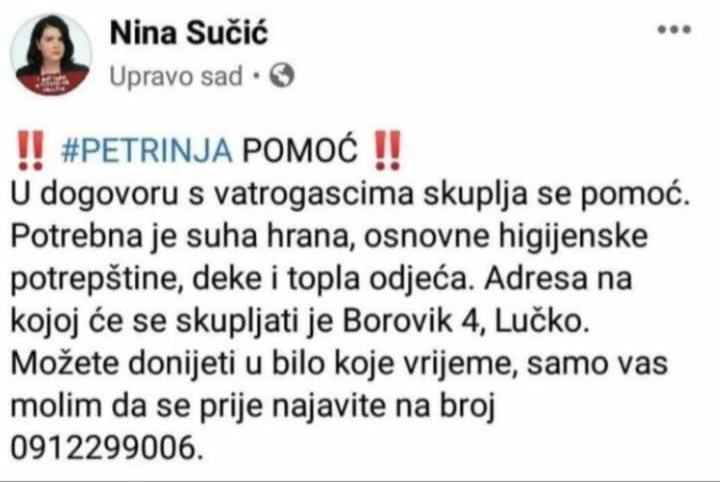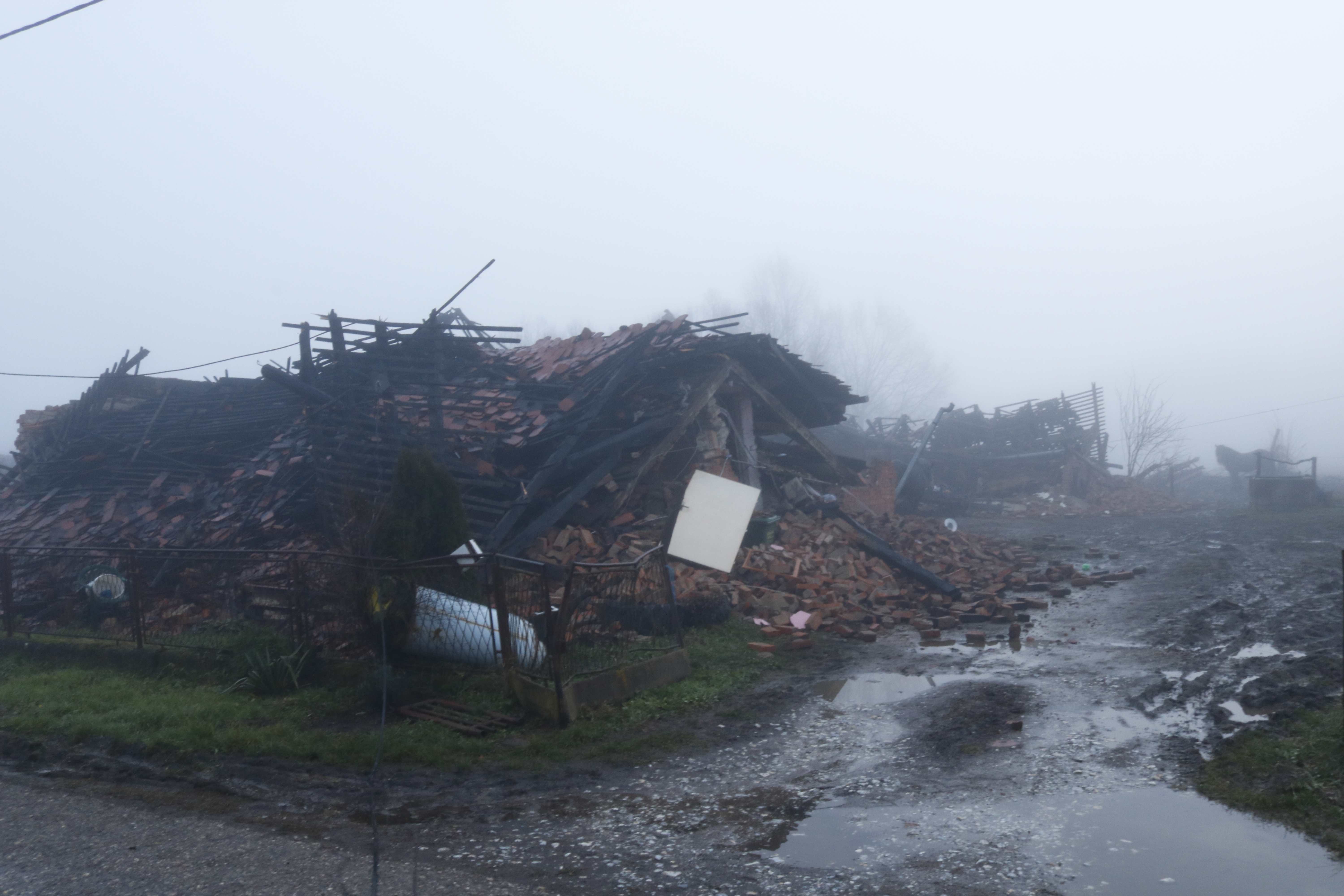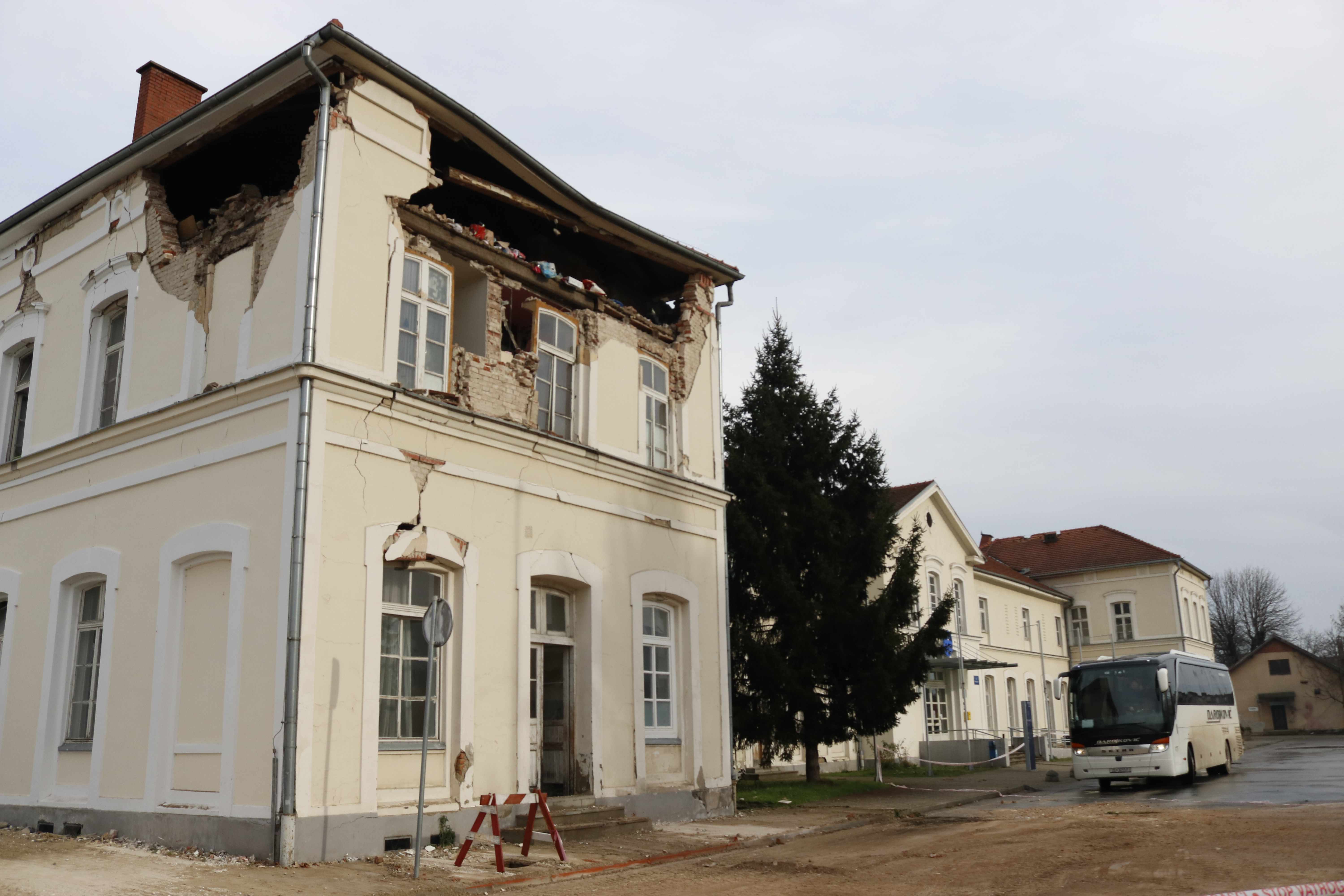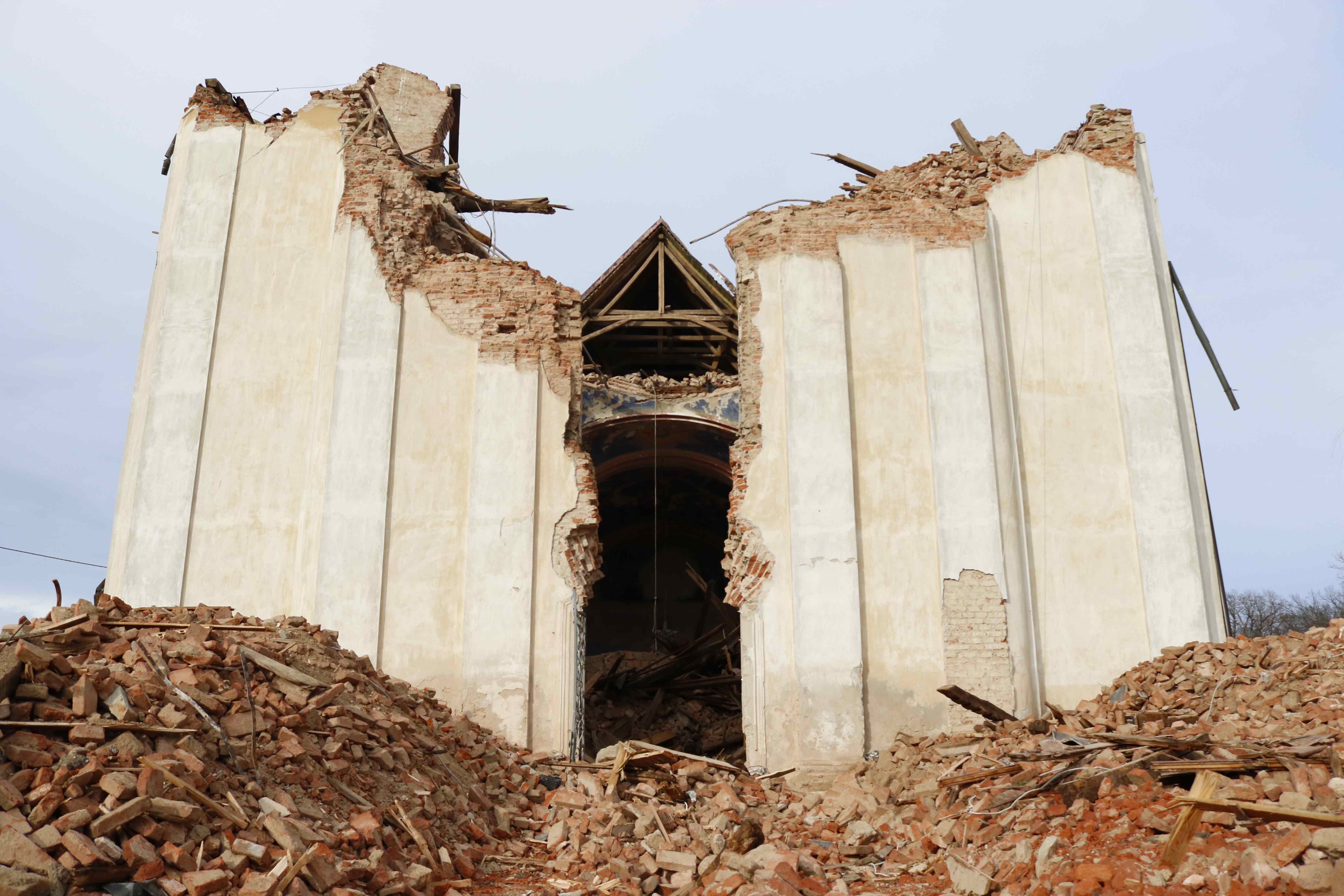Strike at HŽ Infrastruktura Railway Company Called Off
ZAGREB, 24 March, 2021 - Three representative railway workers' unions whose members are employees of the HŽ Infrastruktura railway company have called off a strike announced for noon on 25 March after reaching a compromise solution and signing a new collective agreement with the employer.
The leader of one of the three unions, Mario Grbešić, told Hina that the dispute with the employer had been about two provisions, one being a non-taxable wage supplement and the other meal allowances.
"An agreement has been reached concerning these two issues in a satisfactory way. One will be implemented immediately and the other will be in force as of 1 January next year," Grbešić said.
Under the new collective agreement, to be in force from 1 April this year until 30 June 2022, as of 1 April workers have the right to a HRK 416 non-taxable wage supplement each month.
As of 1 January 2022, workers will receive a meal allowance of HRK 1.30 per each working hour.
They will also receive an Easter bonus of HRK 500, holiday pay of HRK 1,300 and a Christmas bonus of HRK 1,200.
The three unions that were planning to strike represent railway workers, train dispatchers and railway infrastructure workers.
The previous collective agreement expired on 28 February.
The unions further expressed their willingness to postpone negotiations on the cost of labour until the last quarter of this year considering the economic situation caused by the coronavirus pandemic and last year's earthquakes.
For more about politics in Croatia, follow TCN's dedicated page.
Tomašević Announces Reconstruction of Zagreb in Four Dimensions
ZAGREB, 22 March, 2021 - A Zagreb Mayor hopeful, Tomislav Tomašević, warned on Monday on the first anniversary of the Zagreb quake that nothing had been done in the post-quake reconstruction and promised the rebuilding of the city in four dimensions if he won the 16 May local election.
"We have come to know that we do not have not one decision forwarded to the Reconstruction Fund nor has any action been taken," Tomašević told a press conference in front of the City Hall, which was organised by his We Can party and its partners: "Zagreb is Ours " and OraH parties.
He warned that the fund and Ministry of Construction are passing the buck regarding to whether decisions have been written or not and the problems they had outlined during the debate on the Reconstruction Act have now occurred.
He pushed for bringing together experts under the one roof so that good decisions can be made faster.
Tomašević said the current situation could be seen as an opportunity for reconstruction and also for earthquake-resistant development of the city in four dimensions including physical reconstruction which is aimed at increasing earthquake resilience and developing earthquake-proof infrastructure.
The plan is also to reconstruct public places which will give a social dimension to the historical centre of town and suburbs on the rim of Sljeme mountain that will include local construction companies in rebuilding projects and will increase energy efficiency and improve the quality of living as part of the fourth "green" dimension.
MP Sandra Benčić added that the Reconstruction Fund had received money however it was not being used because blueprints had not been approved through a tender that was advertised.
They believe that the key mechanism to fund reconstruction is in the European ITU mechanism of integrated territorial management whereby structural funds are are managed by city agglomerations.
To read more about politics in Croatia, follow TCN's dedicated page.
Plenković: Government Taking Steps to Provide €3.8bn for Post-Quake Reconstruction
ZAGREB, 22 March, 2021 - The government has taken steps to make sure that €3.8 billion (HRK 28.5 billion) can be provided for reconstruction and revitalisation in the quake-affected areas, Prime Minister Andrej Plenković underscored on Monday at the first Croatian conference on earthquake engineering - 1CroCEE.
The conference was organised by the Faculty of Civil Engineering in Zagreb on the first anniversary of the 5.5-strong tremor that struck Zagreb and its environs on 22 March 2020.
Plenković recalled today the extent of the damage to Zagreb and its environs and then later to the Banovina region which was struck by the 6.2-strong quake on 29 December was truly enormous.
The damage is estimated at HRK 86 billion in Zagreb and its environs and HRK 41.6 billion in the Banovina area in Sisak-Moslavina County. The sum total of the quake damage is put thus at HRK 128 billion.
For that expensive and long process of the reconstruction to be implemented it is essential to secure the necessary funds, particularly from European and international sources, said Plenković.
The government has to date taken intensive activities at all levels for reconstruction and revitalisation of affected areas so as to secure €3.8 billion or about HRK 28.5 billion, which is 22% of the funds required.
Of that amount, almost €1.4 billion is from European sources and €2.4 billion through international financing institutions.
The European funds include €684 million from the EU Solidarity Fund for Zagreb's reconstruction and almost €600 million is planned through the Recover and Resilience Mechanism, while €111 million will be reallocated from the Competitiveness and Cohesion Operational Programme from the existing Multiannual Financial Framework (MFF), he said.
In addition, we will endeavour to secure funds from the new EU Multiannual Financial Framework which is currently being programmed and financing reconstruction will be treated as a specific item, said Plenković.
When it comes to international financing institutions, in addition to an already contracted loan of €184 million from the World Bank, talks will be conducted for an additional €1 billion from the European Investment Bank (EIB), €900 million from the Council of Europe Development Bank (CEB) and €300 million from the European Bank for Reconstruction and Development (EBRD).
An additional €319.2 million needs to be added to all that which Croatia requested from the European Solidarity Fund for the removal of damage caused by the earthquake in the Banovina region, he added.
Plenković added that constant talks were being held with a series of development and commercial banks to come up with solutions that will provide credit lines with favourable interest rates for individuals. That primarily refers to the 20% of the costs they need to cover reconstruction, to finance the difference between structural repairs and complete reconstruction, to finance the reconstruction of apartment buildings and also to fund the reconstruction of public buildings by the state.
"We are about to enter the phase of organised structural repairs and comprehensive reconstruction, not just in Zagreb but in neighbouring counties," said Plenković.
He underscored that reconstruction should boost a new large development cycle for Zagreb and neighbouring counties as well as trigger the revitalising of the Banovina region.
World Bank director for Croatia and Slovenia, Elisabetta Capannelli, said that the estimated quake damage was equal to reached 30% of Croatia's GDP.
Minister Says Organised Reconstruction in Zagreb to Start in June
ZAGREB, 22 March, 2021 - Physical Planning and Construction Minister Darko Horvat said on Sunday, ahead of the first anniversary of the 22 March 2020 earthquake in Zagreb, that preparations for the process of reconstruction were underway and that organised reconstruction would start in June.
"The process has not come to a halt. It is complex and is proceeding slowly," the minister said in an interview with Nova TV, noting that buildings damaged in the earthquake had been prepared for demolition or reconstruction.
He noted that a delay was possible if problems occurred in the procurement and appeals procedures.
"But we plan to have concrete contracts and start with organised reconstruction in June," Horvat said.
He noted that the reconstruction process would be carried out by Croatian construction companies but that foreign ones could be hired as well, depending on the dynamic of obtaining the necessary funding.
Asked if the state would cover interest on loans to be taken by citizens for reconstruction costs, Horvat said that this was being discussed with banks and that it yet remained to be seen if the state would also take over the financing of a part of the loan principal.
He recalled that staff at his ministry could help citizens write requests for reconstruction and that those requests could be submitted by mail or through the e-obnova system.
Until all contracts for the entire job of reconstruction are signed, there will be no excavators in the streets, Horvat said.
"If we want to use money approved by the European Commission fairly and in line with strict EC rules, the procedure must be followed," he said.
VIDEO: Zagreb Earthquake 2020, One Year Later
March 22, 2021- On the Zagreb Earthquake 2020 first anniversary, TCN reporters Ivor Kruljac and Jose Alfonso Kusijanović took to Zagreb's streets to see how locals feel one year later.
6:24 AM March 22, 2020. It was Sunday, but sleep was as light as it was a workday full of obligations. Zagreb's citizens were awakened by a horrible sound followed by walls shaking, the ground trembling and things falling all over the place. Amid the coronavirus pandemic, at the very end of the first week of the first lockdown where it was advised to stay indoors to prevent the spread of the virus, there was no choice but to rush out of the house, discombobulated and without a clue of what exactly is the damage that 5.5 magnitude earthquake did. Individuals, couples, and entire families were outside but at a distance from one another, and just after the first aftershock, it started to snow. If you didn't leave the very center of Zagreb, the first sign of damage was the cathedral, whose top of the left tower collapsed, and only later you started to see the images of the center, which many compared online to Beirut. The Covid-19 National Response Team expressed its condolences on TV but warning everyone to keep the distance due to corona. Emergency services rushed to the city, later followed by the army. People who lost their homes were taken to student dorms and other locations with free space in the following days. Sadly, a 15-year-old-girl was fatally injured during the earthquake and passed away at Klaićeva's Children Hospital.
One year later, citizens of Zagreb still have mixed feelings about the event. Here are their answers in our short interview.
Shaking the memory
Senior citizen Ljerka was walking around European Square. Her home survived the quake, and the aftermath was books that fell from a shelf and broken bottles and jars in her pantry. She learned about that damage after a few days when she returned home from her sister's because she was too scared to be alone. The memory of last year still gives her the chills. „I jumped out of bed and lost my head; you have no idea where to go. You don't know what to do. I quickly grabbed something, half-dressed, rushed to the street. People were standing outside confused who didn't know where to go or what to do, nothing“, she said. Describing herself as an optimistic person, the scary experience is still stuck with her even one year later. „You remember it from time to time, but you can't forget it," said Ljerka.
A young guy named Dejan Jakovljević was casually walking around a crowded Dolac market, carefully with a mask to respect the measures in the crowds. He handled the earthquake pretty well as he lives in a new building with lots of concrete and reinforcement.
„It woke me up, but I knew it was an earthquake. It didn't scare me. I just waited for it to be over“, said Dejan. Responding to how he feels about it one year later, he briefly acknowledged that he „honestly forgot about it. “
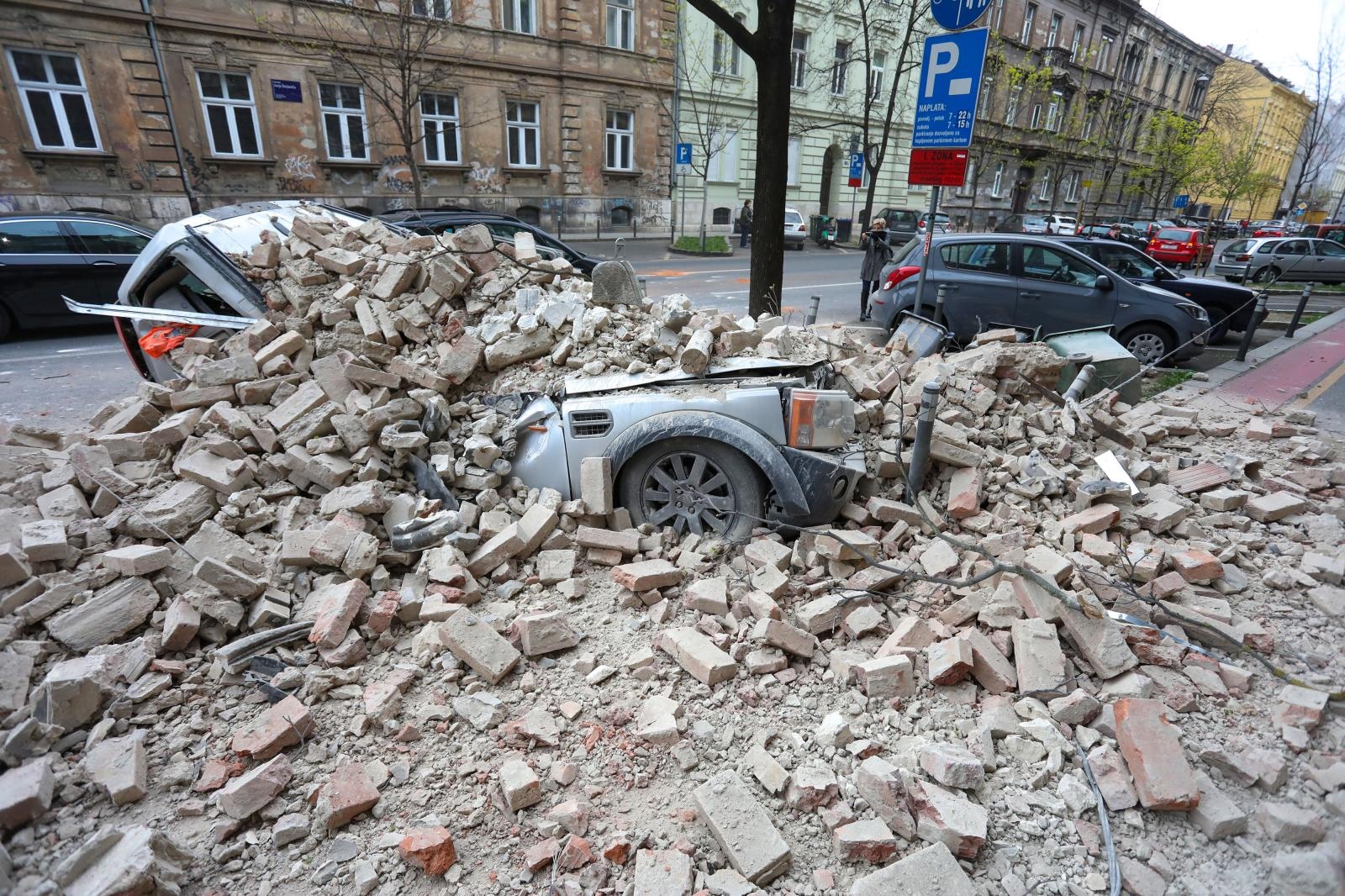
Borna Filic / PIXSELL
The same can't be said for American-born Stefanie Mikac from New York. We met her while she was walking her dog in Zrinjevac park. Her home was badly damaged. „I was in the bathroom dancing left and right. I didn't think it was an earthquake, I thought 'what is it, the devil had come!’ and there was smoke“, remembered Stefanie. When she realized it was an earthquake, she hid under the door, and when it passed, she searched for her dog that hid in the apartment before finally escaping her flat. On her trip to Hawaii, where earthquakes are quite frequent, she accepted that there is not much you can do against mother nature. Despite her bad experience, a year later, she feels safe in Zagreb. „Very secure, safe. You know, you have to take things as they come, “ said Stephanie sharing her positive attitude.
We spotted Mira Francem walking on Jelačić square. Her house was built following all the construction demands and proved to be earthquake-proof. Still, the rocky feeling isn't something that she liked. „I personally felt terrible. I had a feeling the whole world was collapsing, and in the end, that feeling of losing the ground under my feet is an instinct, you know?”, said Mira adding that even though her house is fine, the trembling ground was awful. When asked if there is still anxiety over the last year's event, she resoundingly repeated, “yes.”

Borna Filic / PIXSELL
Mladen Habuš was standing on Vlaška street that connects European Square with Kaptol, where the City's cathedral is located.
“My home was okay. The earthquake surprised everyone at first, but fortunately, they don't last, so you stabilize psychologically”, said Mladen calmly, as if it didn’t really leave an impression on him.
“I already forgot about it because it's not as frequent as in Glina or Petrinja, whereas they say, it shakes every five minutes,” he emphasized, and that the key is to remain relaxed.
December – another round, another rumble
The second earthquake with a 6.4 magnitude that hit Petrinja and ravaged Banovina / Banija didn't damage Zagreb as it did to the southern part of central Croatia. Still, it was certainly felt, and many agreed it was stronger than the one in March.
„Jesus Christ! That one was even worse!“said Ljerka the second I mentioned the Petrinja earthquake. She learned that Zagreb is situated in a seismic active area, and earthquakes are something people in Zagreb need to learn to live with, but March didn't make her welcome the December tremble with more ease. She ran out of the house, not knowing what when her niece, who also lives in Zagreb, called her.
„I asked her if there was another earthquake in Zagreb. I didn't get anything. She said, 'no, that's the aftermath of Petrinja.' We are really close to Petrinja“, said Ljerka.

Nikola Cutuk / PIXSELL
Stephanie was walking her dog during the Petrinja earthquake. She witnessed bricks falling and was relieved nobody was passing underneath at the time. However, when she returned home, she entered the mess, and the damages that were still not fixed from March intensified. „All the cracks are wider now, and everything will need to be taken down to get to the healthy wall,” said Stephanie.
When asked if the December quake was easier or the same to handle for her, she laughed, acknowledging that it was actually worse. “We repeated the reactions from the first earthquake, you know? It's a very unpleasant feeling even today when a tram passes or something buzzes. I think something is trembling, and we are quite tense”, shared Mira. She said that no matter how rational you are, consequences as emotions are different from rationale. “I'm really sorry for those people. My house isn't damaged, but I was scared and lost, and I can only imagine how those people felt. It's a huge catastrophe on which we cannot influence,” said Mira with empathy.
Dejan felt the December quake was stronger but feeling safe in his building; he wasn't too worried. “I instinctively rushed to save the TV. Everything else was irrelevant”, recalled Dejan with gentle laughter underneath his mask.
Despite Mladen being relaxed after Petrinja, anxiety crept up on him too. “You start listening; someone starts a car, you raise your head to see what's going on. You are expecting another earthquake”, said Mladen. Still, he added that “you get used to it.”
Insurance vs. safe building
As revealed earlier this year, 85% of Croatian households don't have earthquake insurance.
Dejan doesn't know if the building had insurance but given his building proved safe, he didn't seem too concerned with that question.
Mira also didn't have insurance, but her investment in the safe building certainly paid off.
Stephanie's home was badly damaged, but she pays 1200 kuna annually for insurance and says it isn't too expensive in Croatia. However, regarding the walls in her home that need to be fixed, there was a bit of an issue. „The insurance company actually secured only the furniture, but then through a lawyer, we made a deal to cover half of it. Something is better than nothing“, said Stephanie.
Ljerka complemented her landlord and how she manages things. Her building received a green sticker but chimneys needed to be removed. Insurance helped there a lot. „We took down the chimney ourselves, and we got the money back, I think 3000 kuna, “ said Ljerka. The roof was renewed a year or two ago, but the same couldn't be said about the terrace residents have in the back of the building. Insurance didn't want to cover it, and a loan was needed to be taken for the fixture.
City officials to the rescue! Or not?
Both the country and international community, not to mention companies and individuals, rushed to help Zagreb, and the now-deceased mayor Milan Bandić found himself challenged to return Zagreb to its old glory and shine as fast as possible. The situation even called for a Zagreb reconstruction bill on the parliament level as the government took the lead in rebuilding the city. In the meantime, Bandić passed away, and with local elections coming up, the city's repair remains a topic for all the candidates that hope to take the lead chair of city politics in May.
Regarding the response of the city officials, Ljerka isn't happy.
„What did the city do? Nothing. It was all ruins. Look at what Zagreb looks like now after the earthquake. How long has passed, and nothing is done. Nothing. Only the houses that people renovated themselves, but the city gave nothing”, commented Ljerka. She did, however, add that the city doesn’t have money and that she understands that.
Mira shares Ljerka's opinion that the situation is better for those who organized repairs privately. Still, when it comes to the city authority response, she says, „it should have gone faster, better, and more organized. “
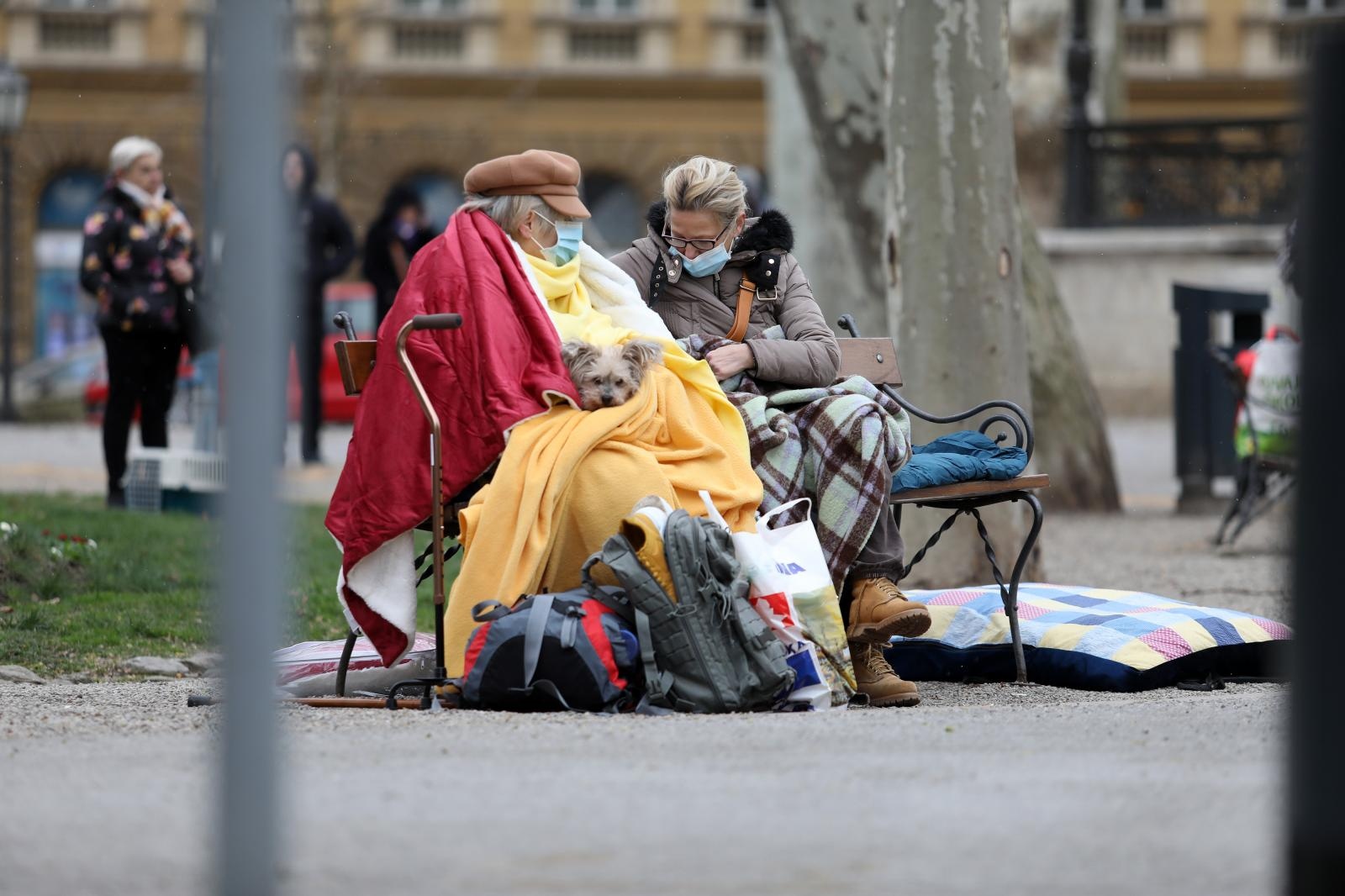
Borna Filic / PIXSELL
„I see a lot of my friends who live in the center. It's all at a standstill. For those who engaged themselves privately, it is better, but otherwise, it is prolonged. It needs to be better, more active, more engaged to ease the people and make them stronger."
Dejan also thinks that the authorities' response was not good and that “they should help people.“
When asked to comment on the city's response to the earthquake damage, Stephanie was hesitant at first. She feared many people would disagree with her opinion and her different way of thinking because she lived in the US.
“Over there, we have asbestos insurance and insurance for everything. If you have a bank loan and the bank has input on the house, you have to have insurance”, explained Stephanie asking me if it is fair for her to pay the insurance while others don’t and later demand the city to pay for everything. “Imagine if the city would fix apartments for everyone and secure the buildings. Nobody would ever do that anywhere. They may give you a percentage, but that's it,” concludes Stephanie.
Mladen is happy with the city's response.
“I think the city, to my knowledge and how much I followed, was the only one that jumped to help those who lost their homes and put them in free spaces,” Mladen pointed out. He also reminds us that the government took over the rebuild and the city is involved with 20%. When asked if it’s good for Zagreb that the government took the lead over the city, a resounding yes was the final answer. “The city doesn't have enough money, so the government needs to jump in," concluded Mladen.
Steady ground wishes above all
Being the biggest and the capital city of Croatia, which attracts people from everywhere in the country and beyond, Zagreb streets offered truly diverse answers to Jose and me. There was more or less fright on March 22, 2020, and different levels of anxiety today. Different views on insurance and the city’s response. We can only guess how differently they will vote in May. But one wish is the constant for the Purger's hearth - the wish to see Zagreb as a safe city where you only get awakened by an alarm clock.
For more about the earthquake in Zagreb, follow TCN's dedicated page.
Quake Damage Done to Cultural Heritage in Central Croatia Estimated at €640 Million
ZAGREB, 19 March, 2021 - Damage done to listed buildings and monuments in the quake-hit Sisak-Moslavina County has been estimated at €400 million, while the total damage done to cultural heritage in all the quake-hit areas of Croatia is put at €640 million.
These figures were presented on Friday after Culture Minister Nina Obuljen Koržinek met the task force for dealing with quake aftermath in Sisak-Moslavina County for the talks on registering the damage to cultural heritage.
Obuljen Koržinek informed the task force of the next steps to be taken including urgent measures for the protection and preparation of documentation for the reconstruction of individual listed buildings and monuments.
Reconstruction will be such that it will preserve all the features of the area, however, (listed) buildings will also be renovated to be quake-resistant and energy efficient, the minister said.
Yesterday, we estimated the damage to cultural heritage at €640 million, with just over €400 million in Sisak-Moslavina County and just over €200 million in the nine other affected counties. As far as listed buildings in Petrinja alone are concerned, the damage done to them is estimated at more than €100 million, said Minister Obuljen Koržinek.
For more about earthquakes in Croatia, follow TCN's dedicated page.
Interview: HGSS Croatian Mountain Rescue Service in Petrinja
December 31, 2020 – Croatian firemen, army, police and medical workers worked through after the earthquake in Sisak Moslavina County on 29 December 2020. We wanted to get a sense of the demand on and the experiences of emergency services, so we spoke with Josip Granić. Head Of Service for HGSS, who was coordinating the efforts of the Croatian Mountain Rescue Service in Petrinja
This interview took place in Petrinja, just before 12.30pm on Wednesday 30 December 2020
Right now we have around 120 people here. Last night we sent some home. During the height of the operation, we had 192 members of the Croatian Mountain Rescue Service in Petrinja and the surrounding towns and villages. Firefighters and police from all over Croatia came. There are more than 200 army personnel here too.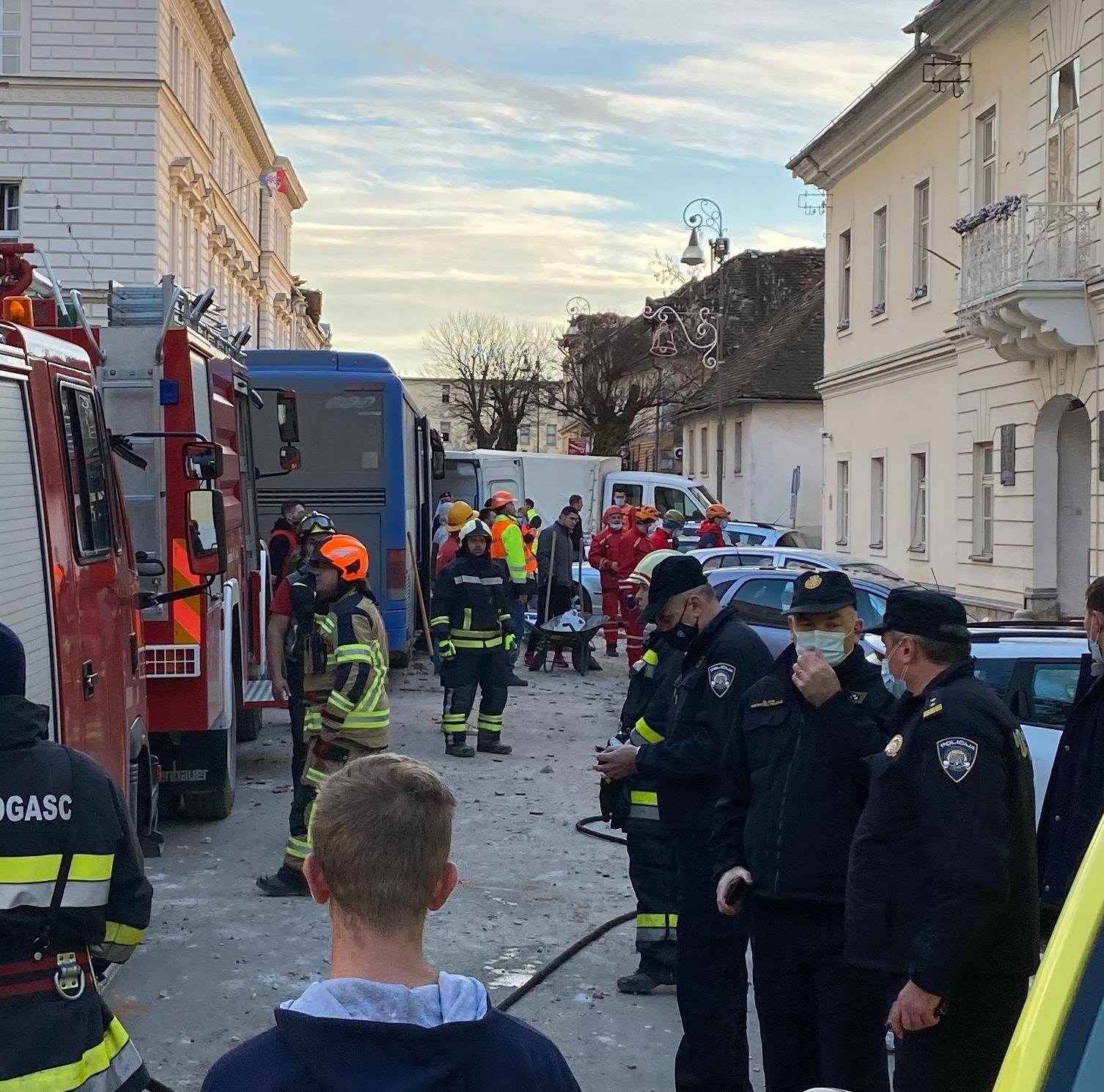
Because we are part of the operational team of the National Civil Protection, we were already here and involved in the response to the first earthquake. After yesterday's earthquake, I called each HGSS station across Croatia and asked them to prepare at least one vehicle and one team to come and join the Croatian Mountain Rescue Service in Petrinja. The first extra teams to arrive were from this county - Sisak and Novska. They got here around 2pm. Teams from Orebic, Peljesac and Split arrived maybe last, because of the large distance they had to travel. One team came by car, another came by helicopter.
What was the situation like for Croatian Mountain Rescue Service in Petrinja when the wider team first started to arrive after the second day's larger earthquake?
If I said it was chaos, that wouldn't be strong enough a word. The centre of the town was chaos. Everyone was busying themselves with responding – people were moving debris, firefighters were making their way through, ambulances and police moving through, people of the city in the streets helping out. The streets were filled with dust and smoke. You could hear the sounds of floors and roofs and buildings collapsing all around you.
What were the first undertakings for the Croatian Mountain Rescue Service in Petrinja?
Well, our first response was not only in Petrinja – we were immediately in some of the surrounding villages too. The very first thing we did was send in our search teams and the specially trained dogs we work with. We were instructed by locals. They told us which of the collapsed buildings were likely to have people trapped beneath them. We immediately found one person. It was in the town hall. One lady. The entire ceiling had fallen on top of her. Our colleague from Ogulin found her with his dog. The firefighters worked so fast, so hard to dig her out. They were excellent. It took four and a half hours to get her out. She was lucky. Unfortunately, we also found four more people who were already dead.
We saw quite a lot of volunteers. Who is organising them?
There are many different groups. Many local people were the first ones out on the streets, volunteering. Then, those from the immediate area came - four friends in a car, that kind of thing. |NGOs arrived next – veterans, charities and so on. Then, football fans from all over Croatia arrived. Supporters groups had organised coaches to bring themselves here. At first, nobody was organising them and it was a bit of a problem. They organised themselves. But, it was such chaos that some emergency vehicles, including search and rescue teams of Croatian Mountain Rescue Service in Petrinja, could not pass through the town. This is dangerous because, in search and rescue, your ability to respond quickly is vitally important. After dark, things began to run more smoothly. Many worked until 3am or 4am, then they were sent home. The ones who didn't arrive until much later in the night were incorporated into Civil Protection and assigned to work the next day in villages and towns outside Petrinja, where help was needed.
How has the demand on what you do changed since yesterday?
It hasn't changed that much. We have been visiting villages throughout the county as quickly as we can, searching for people who may be trapped. Some of these places have not yet been reached by the other emergency services, but they will get to them. We found another alive person who was trapped today. Since early in the morning we have searched 84 villages.
What advice would you give someone who wants to come here to volunteer?
Organise it first with Civil protection. If it is organised with them, then you know you won't be in the way and you will be going to where help is needed. If it's organised with them first, then come. There's a job for everyone who wants it here.
How different is the demand on emergency services in this earthquake compared to the earthquake in Zagreb in March 2020?
Well, our services were not requested during the Zagreb earthquake and a lot of that is because of the structural integrity of the buildings in Zagreb. Most were strong enough to survive that big earthquake. The ones which were damaged were only partially damaged. Many buildings in Zagreb were hardly damaged at all and so many people in Zagreb were relatively unaffected by that earthquake. Here, everyone is affected.
All images © HGSS
PHOTOS: Majske Poljane, Glina and Petrinja One Day After The Earthquake
December 31, 2020 – Total Croatia News visited Majske Poljane, Glina and Petrinja one day after the earthquake. It is difficult to find words to describe the devastation we saw. Perhaps pictures tell the story better
Majske Poljane

Majske Poljane is a rural community. Such was the devastation here, it was difficult to tell which of the destroyed buildings had yesterday been used for agriculture or if they'd been homes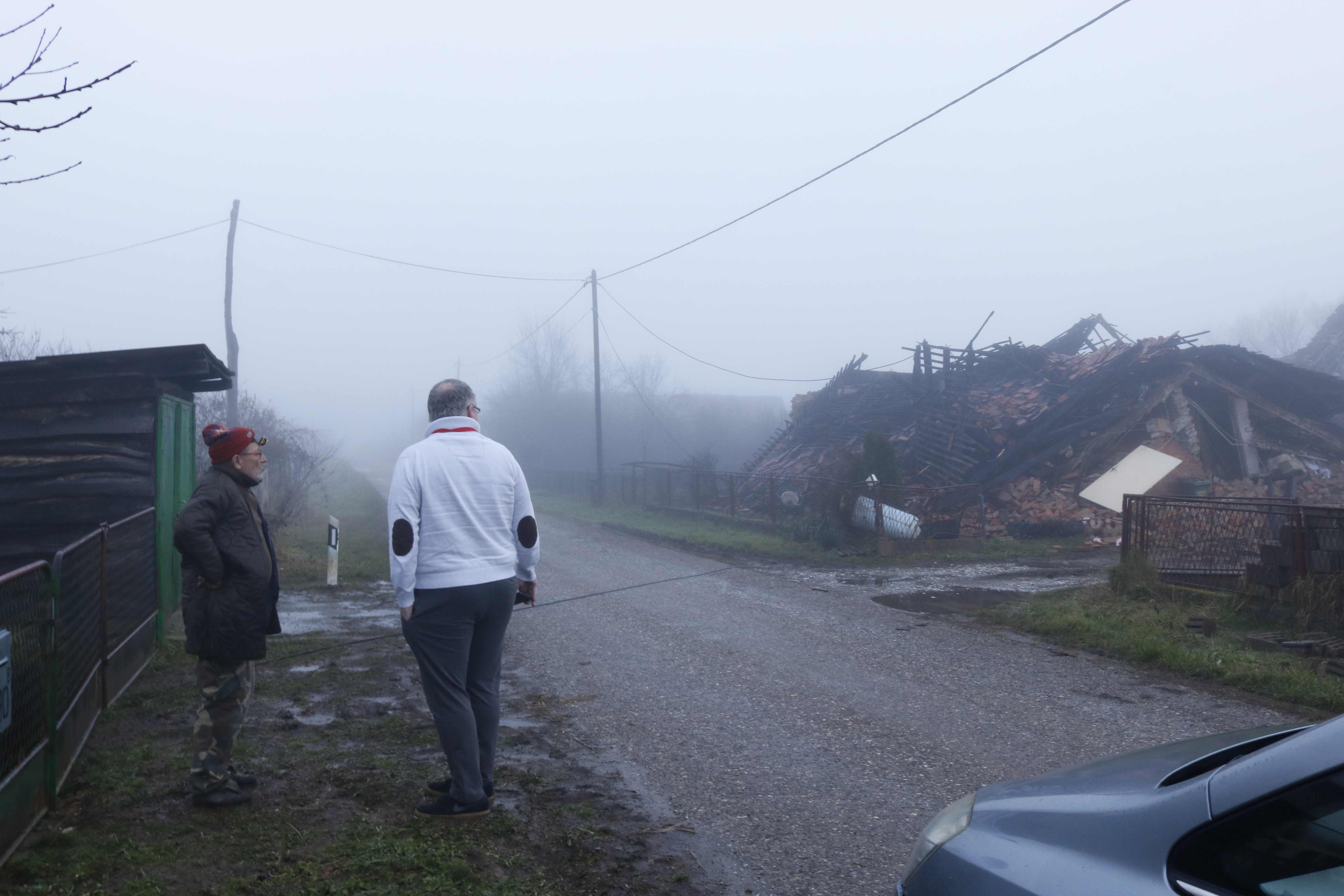
TCN's Paul Bradbury talks to Majske Poljane resident Vladimir who confirmed that, yes, the building across the lane had been a home, his neighbours had lived there just 24 hours earlier
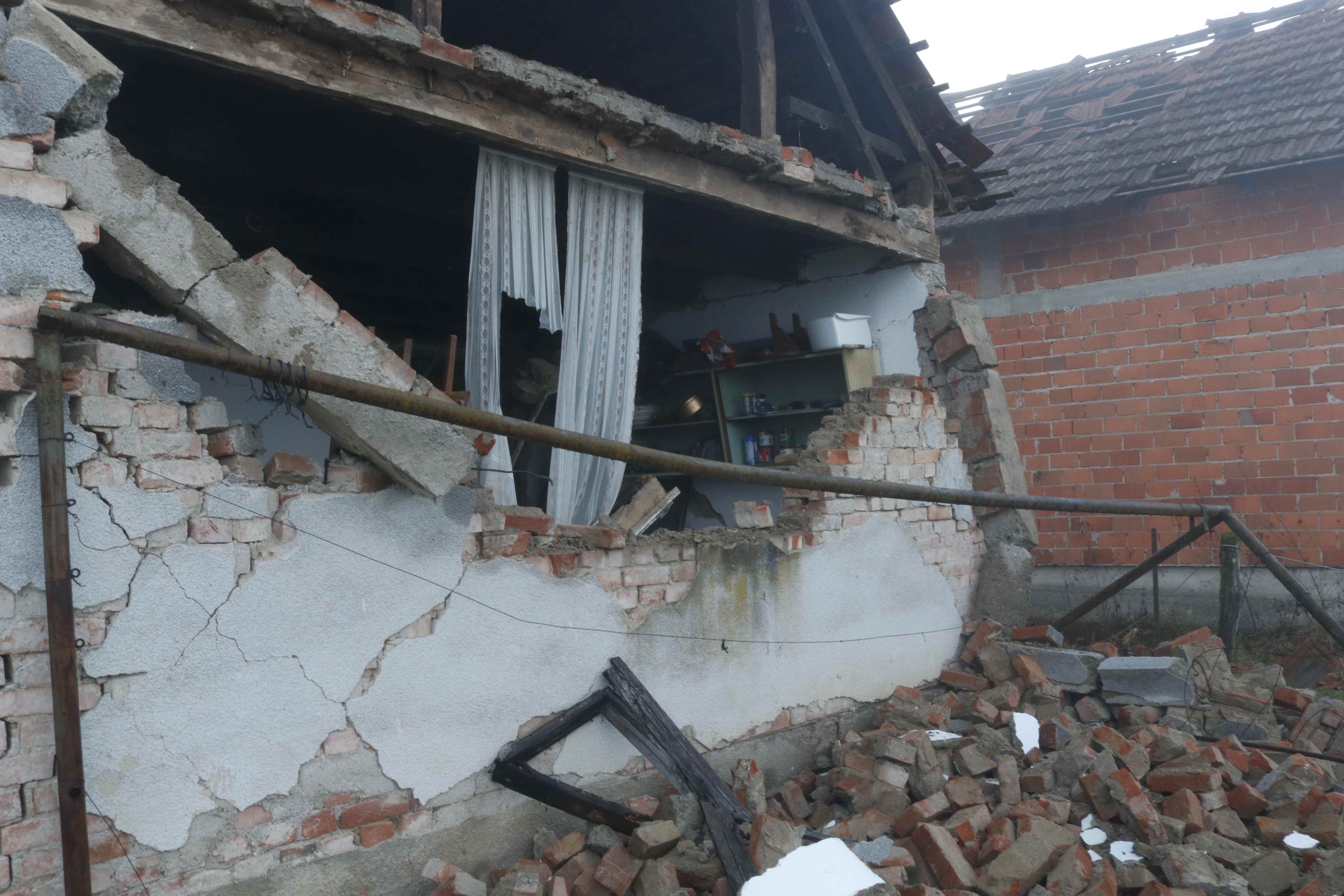
Doors of houses left ajar, windows collapsed, smashed and broken. Inside, you can see everyday lives, stopped suddenly, frozen in time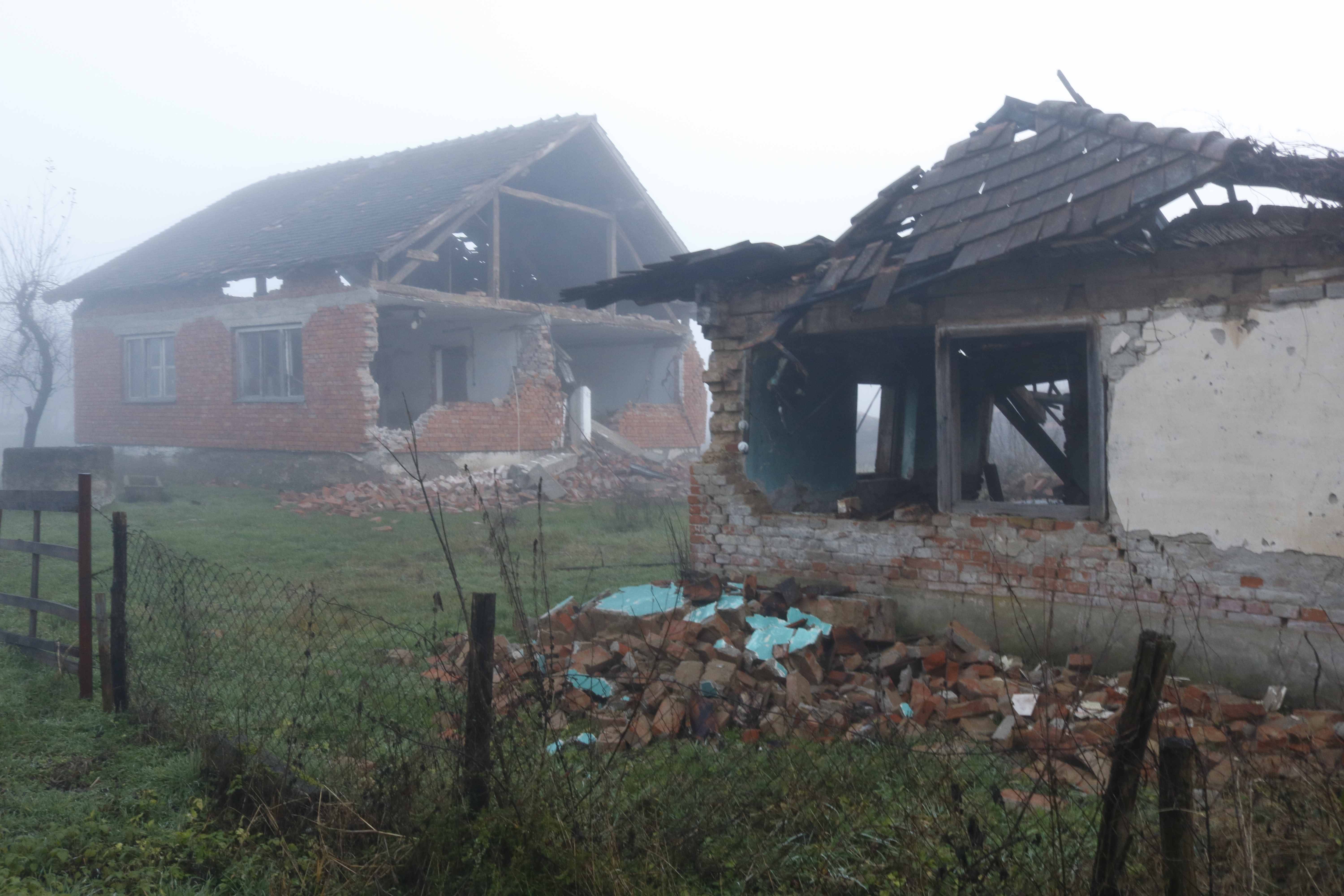
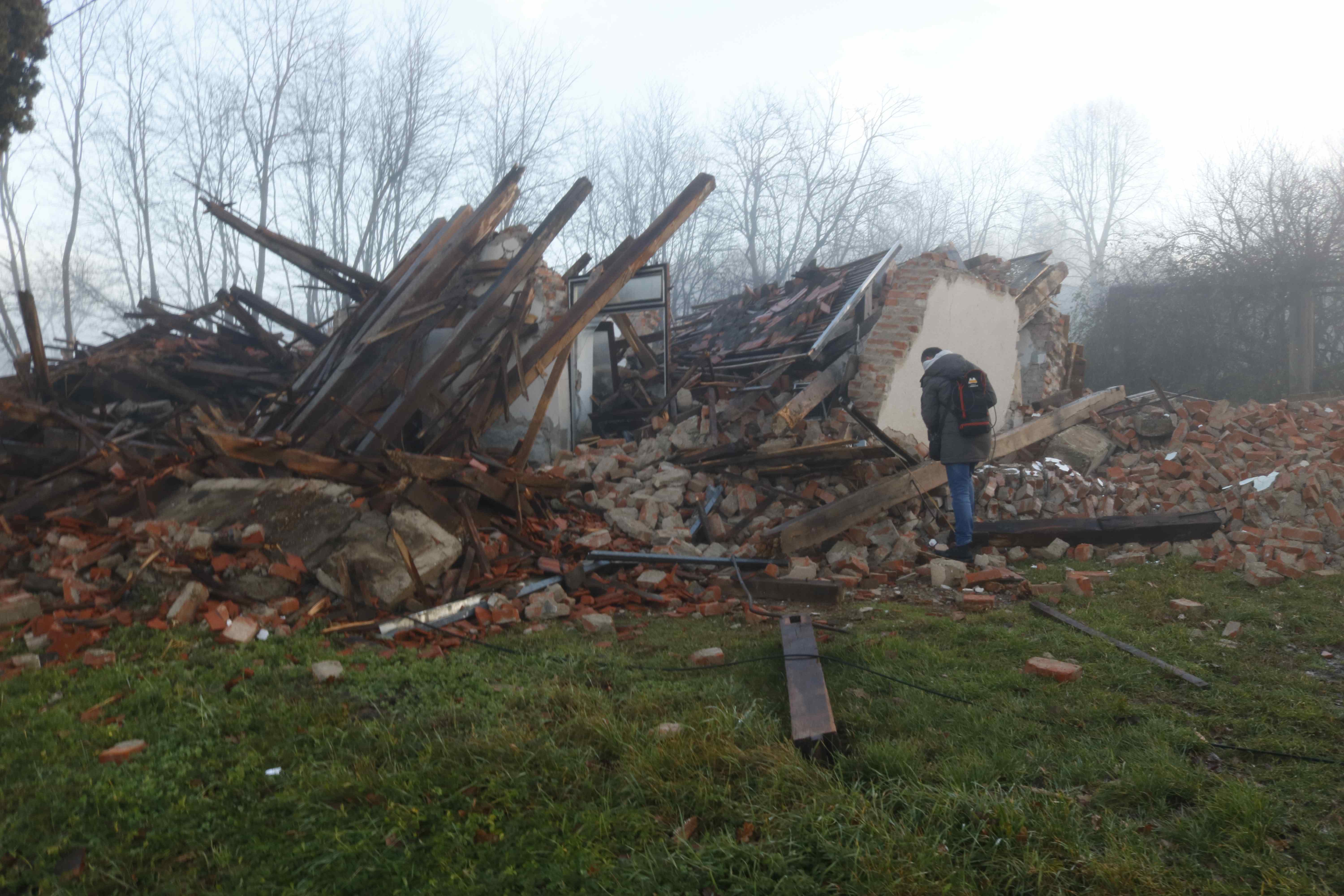
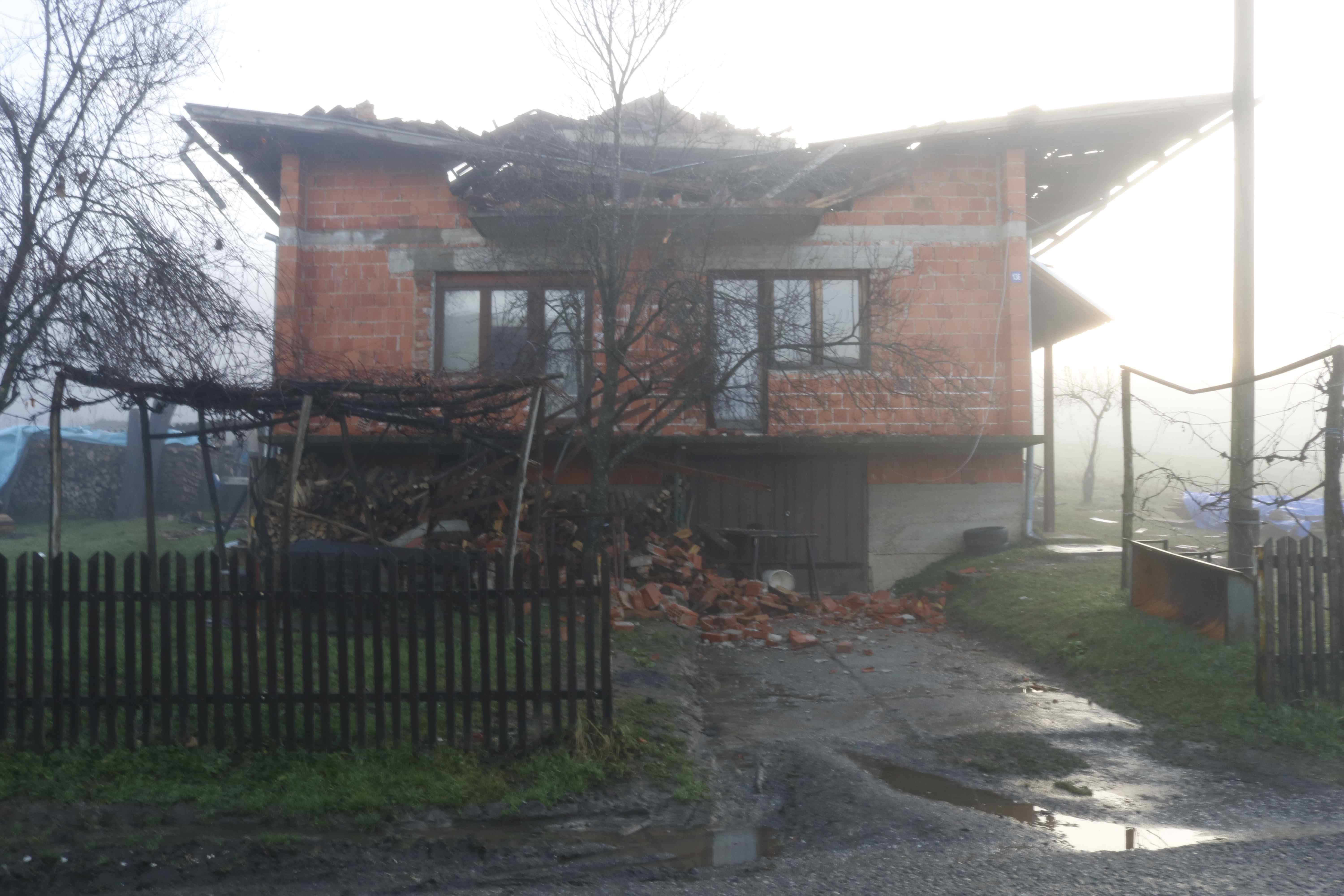
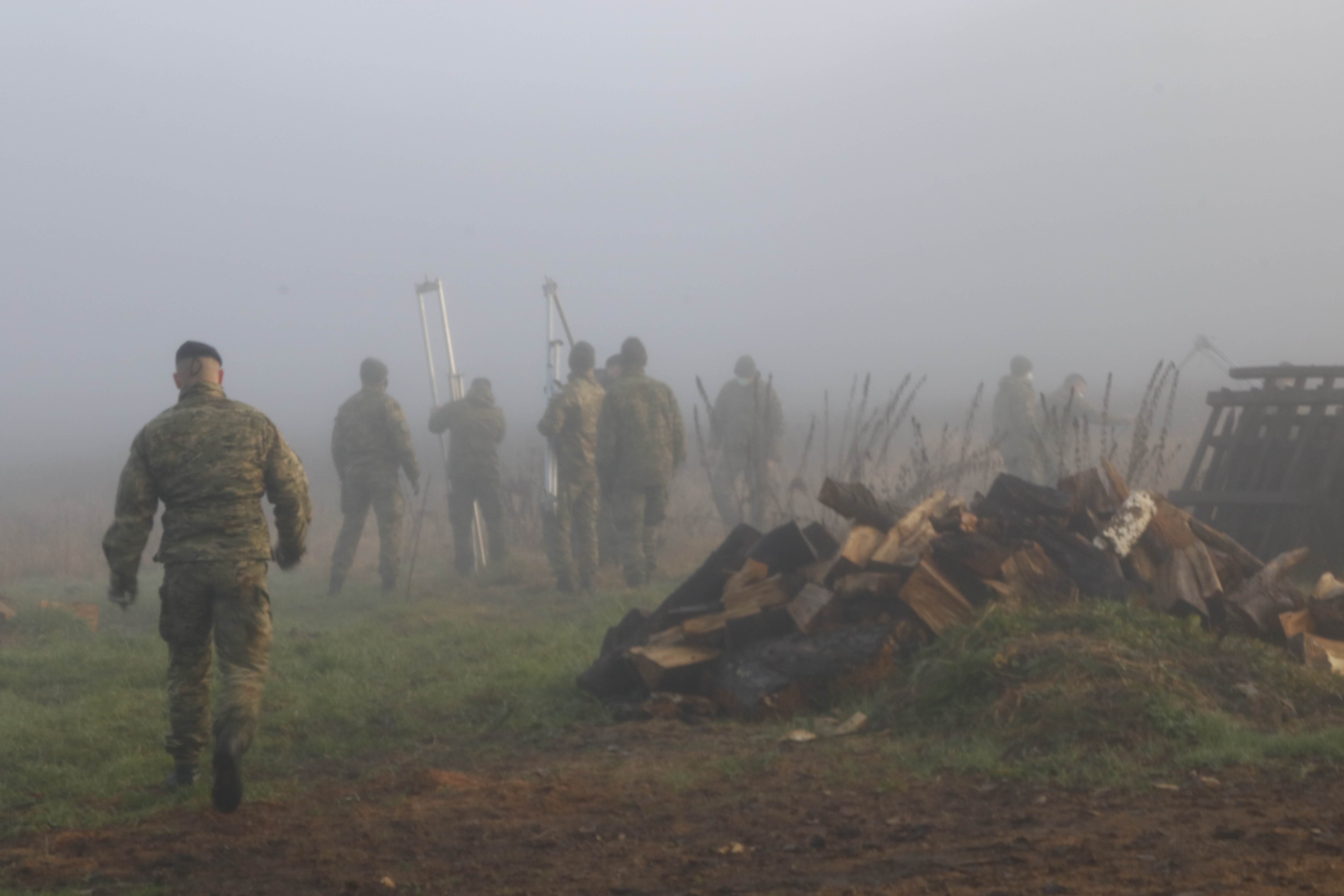
Croatian soldiers quickly constructing emergency shelters in the freezing fog of early morning. They came from all over Croatia. Unsure if their damaged houses were structurally safe, parents and children of Glina, surrounding villages and Petrinja stood in gardens and fields, keeping warm around fires. With no electricity, they cooked on barbecues.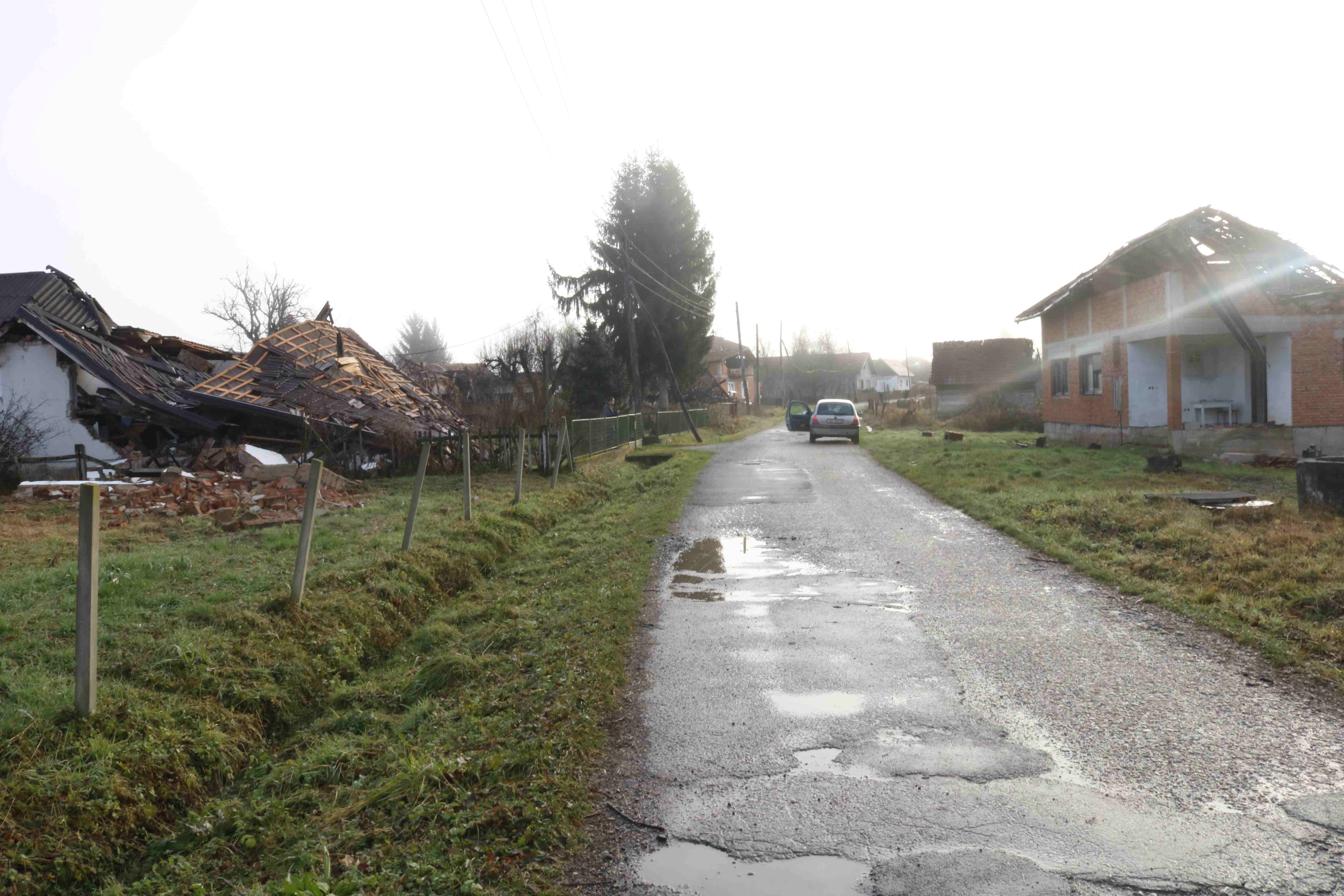
Majske Poljane seemed like the most silent place on earth. No single sound, not even bird song.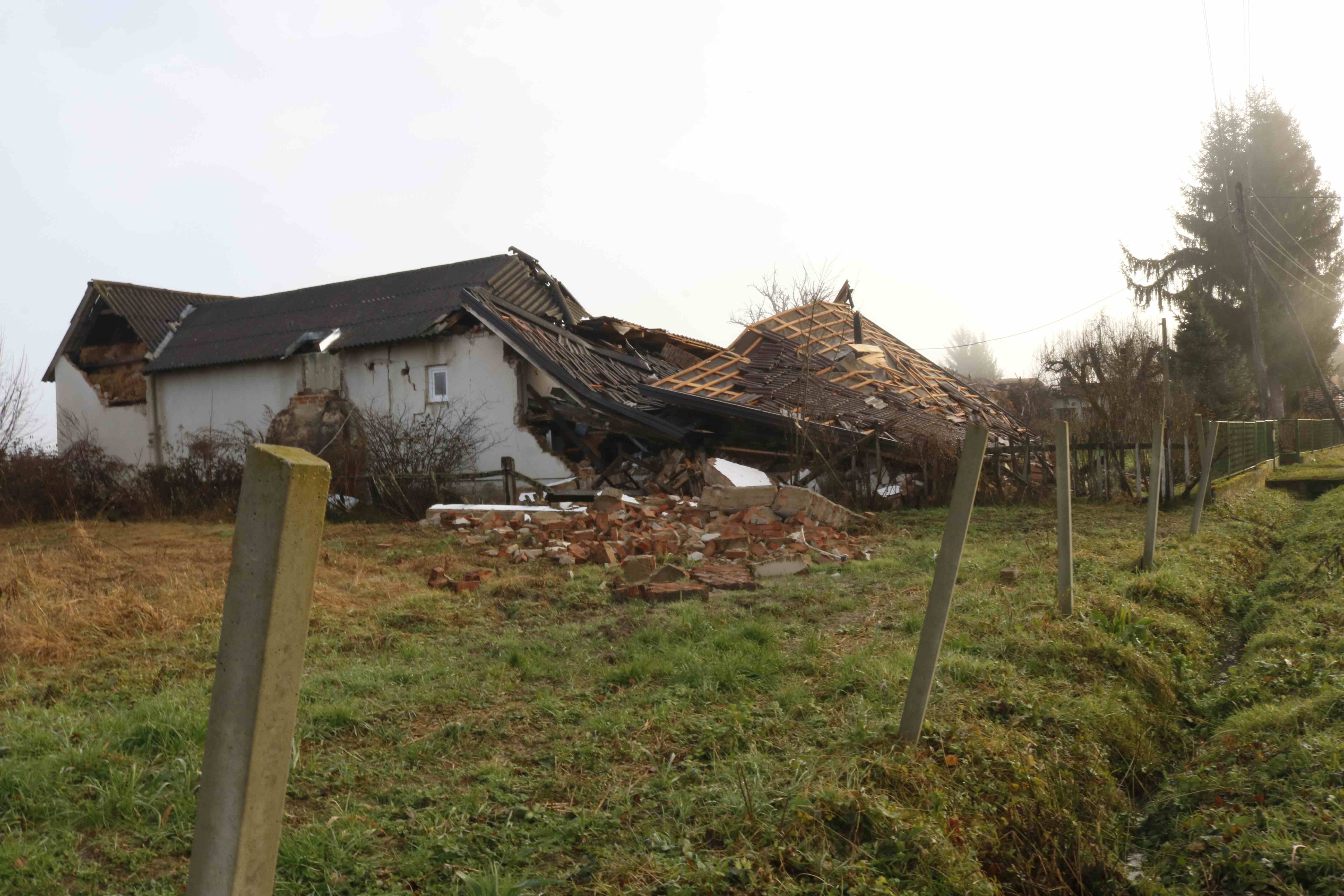
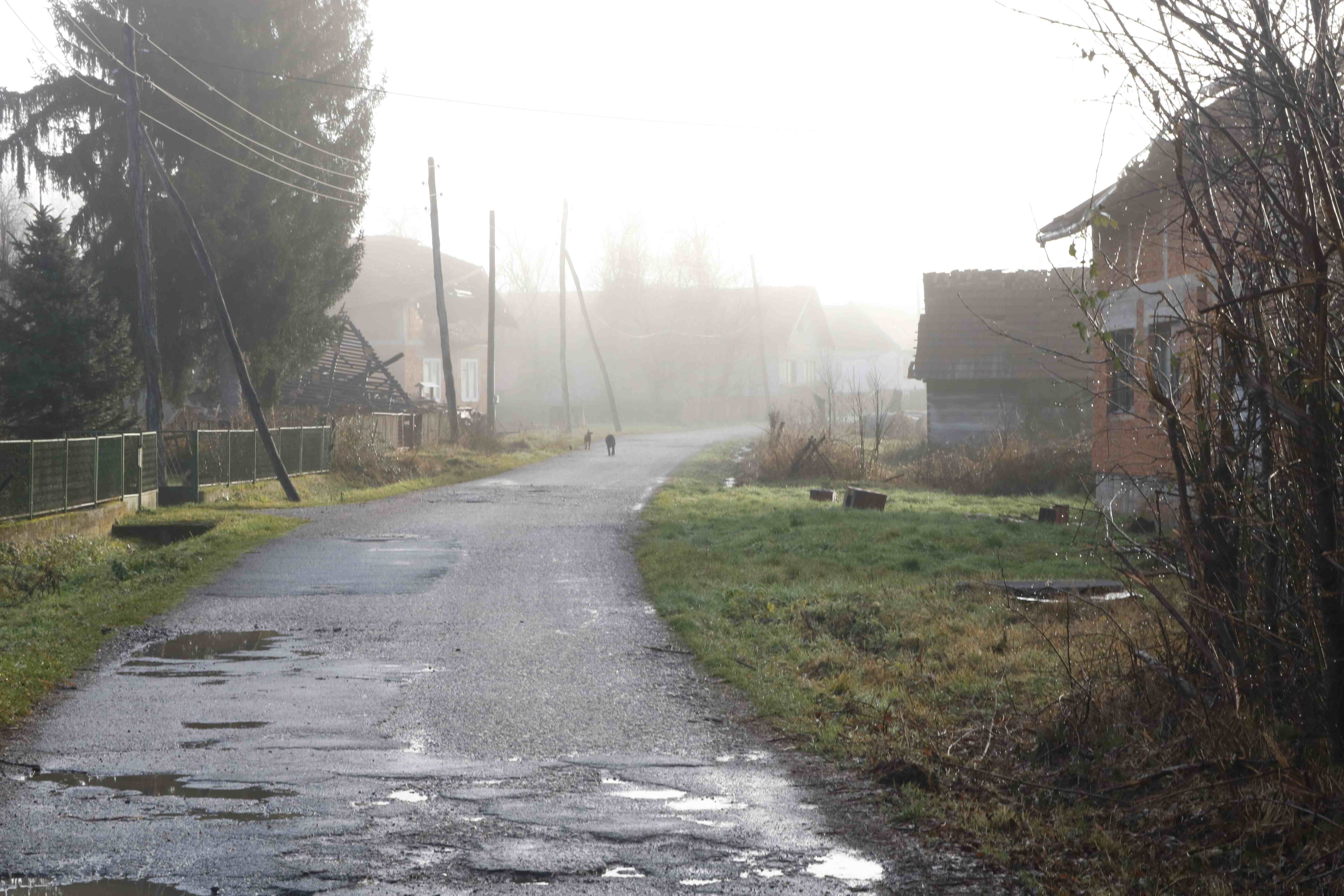
Even the three village dogs left behind padded around the wet road in silence
Glina

Croatian firefighters walk heavily through the mist-filled streets of Glina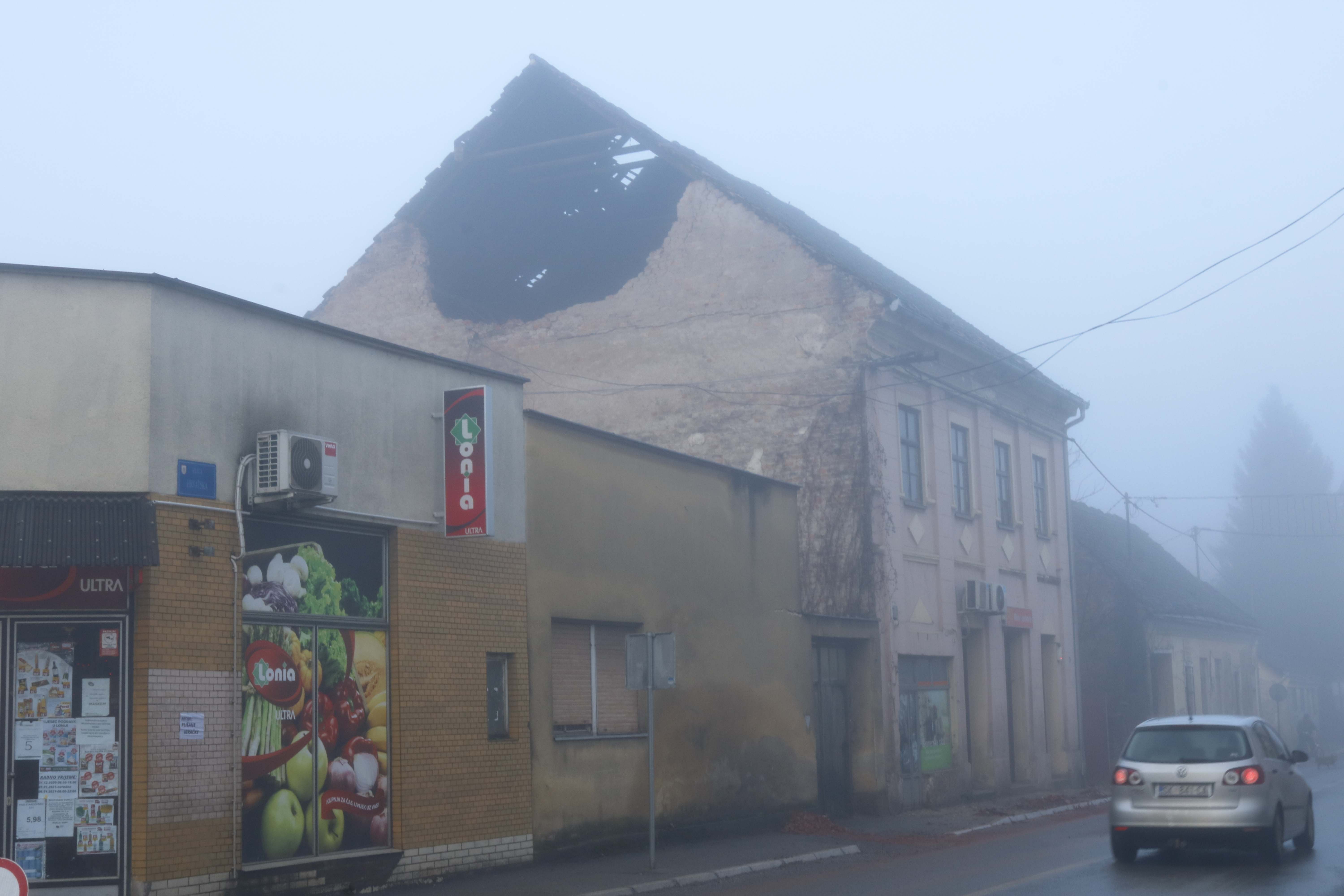

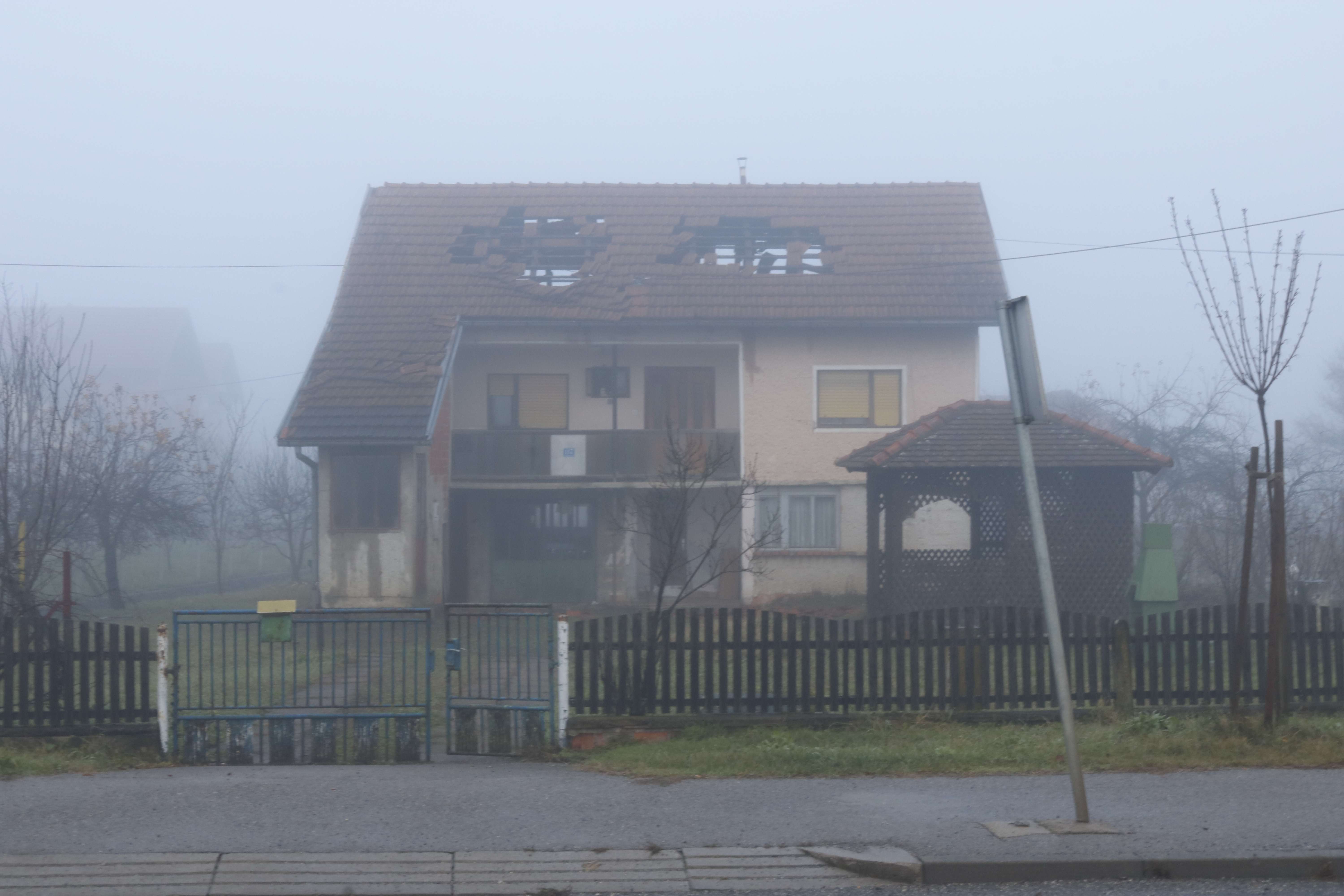
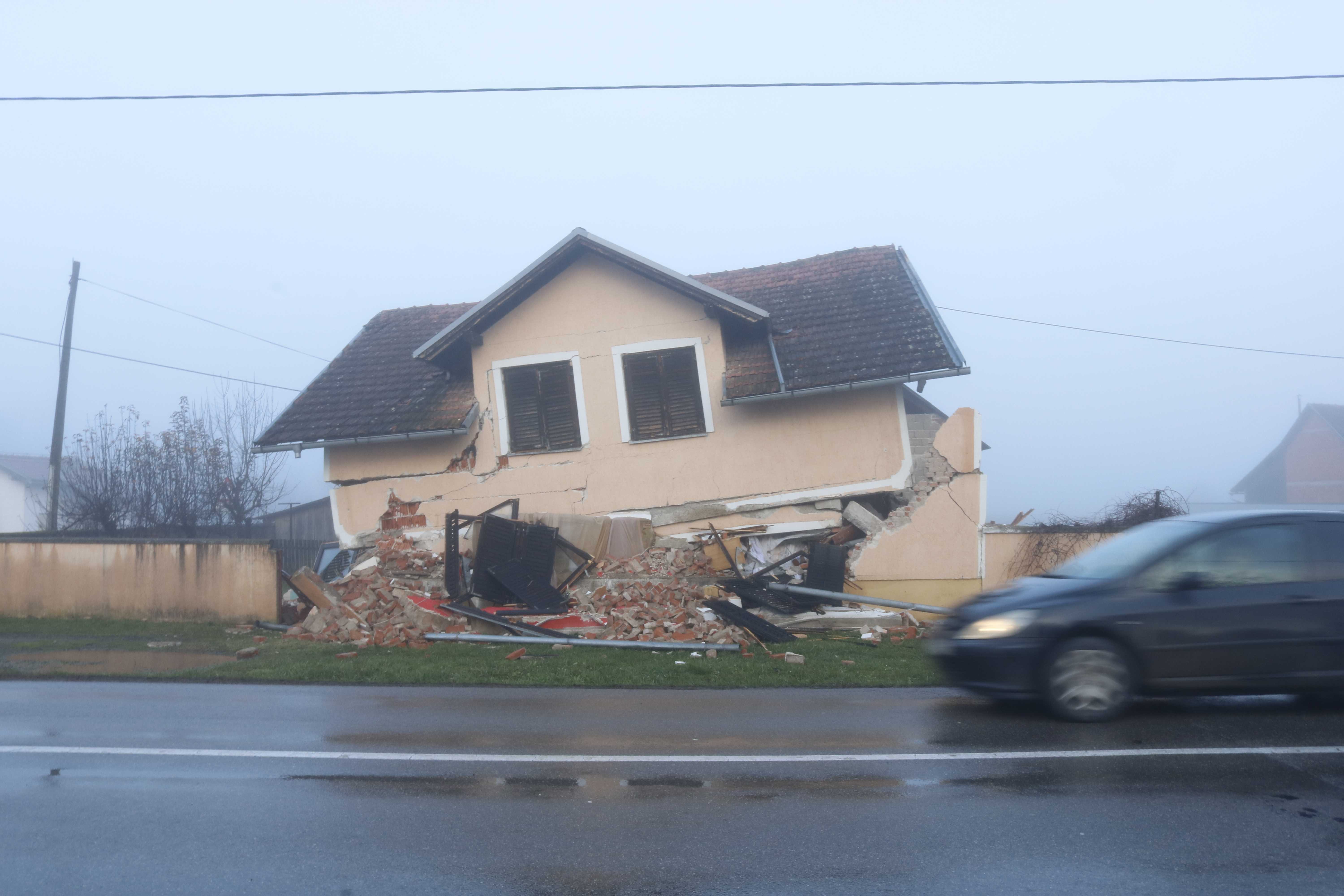
The entire upper floor of this house had collapsed, crushing completely the floor underneath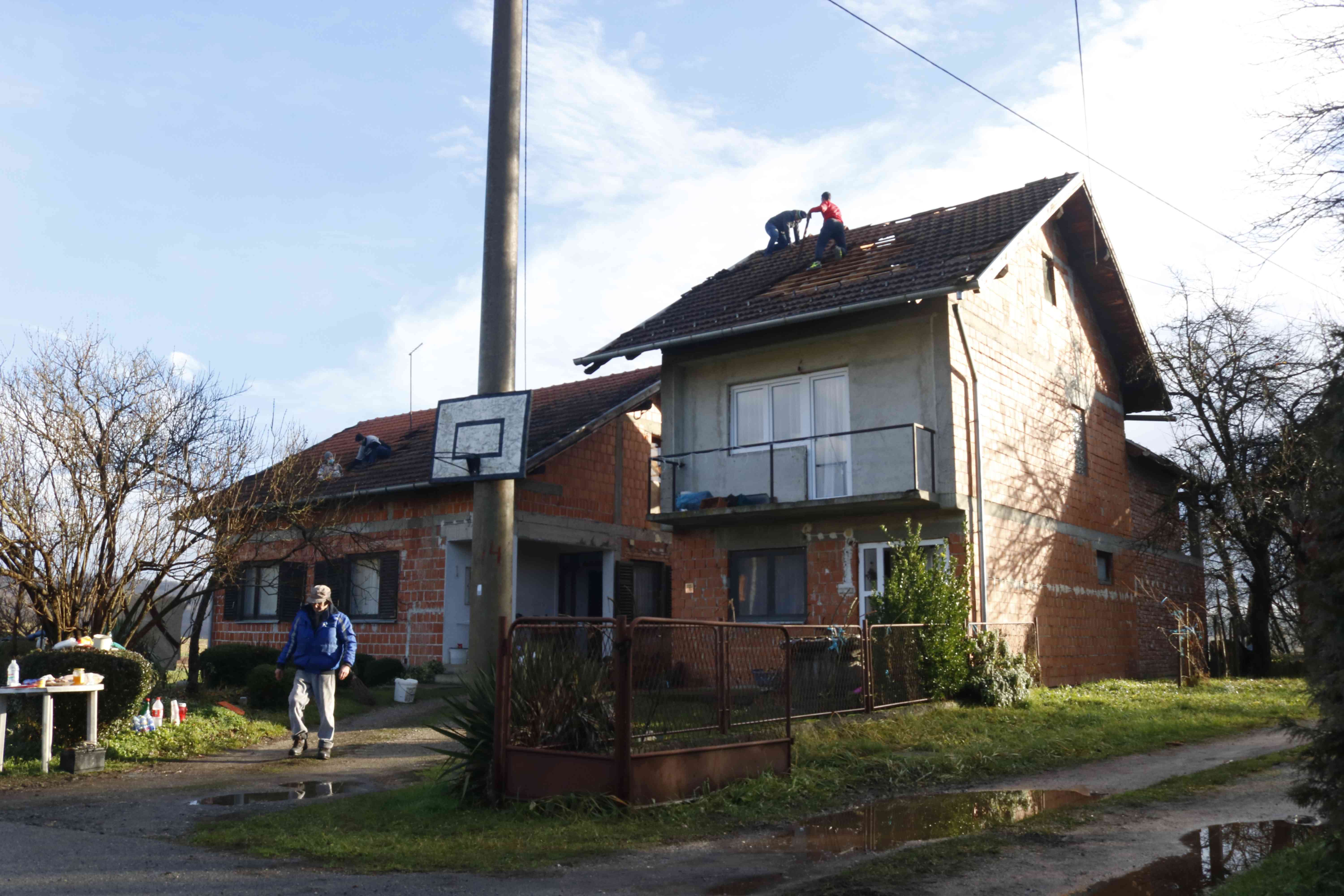
Volunteers at work on the roofs of two neighbouring houses, between Glina and Petrinja one day after the earthquake. The volunteers had come from all over Croatia
Petrinja one day after the earthquake

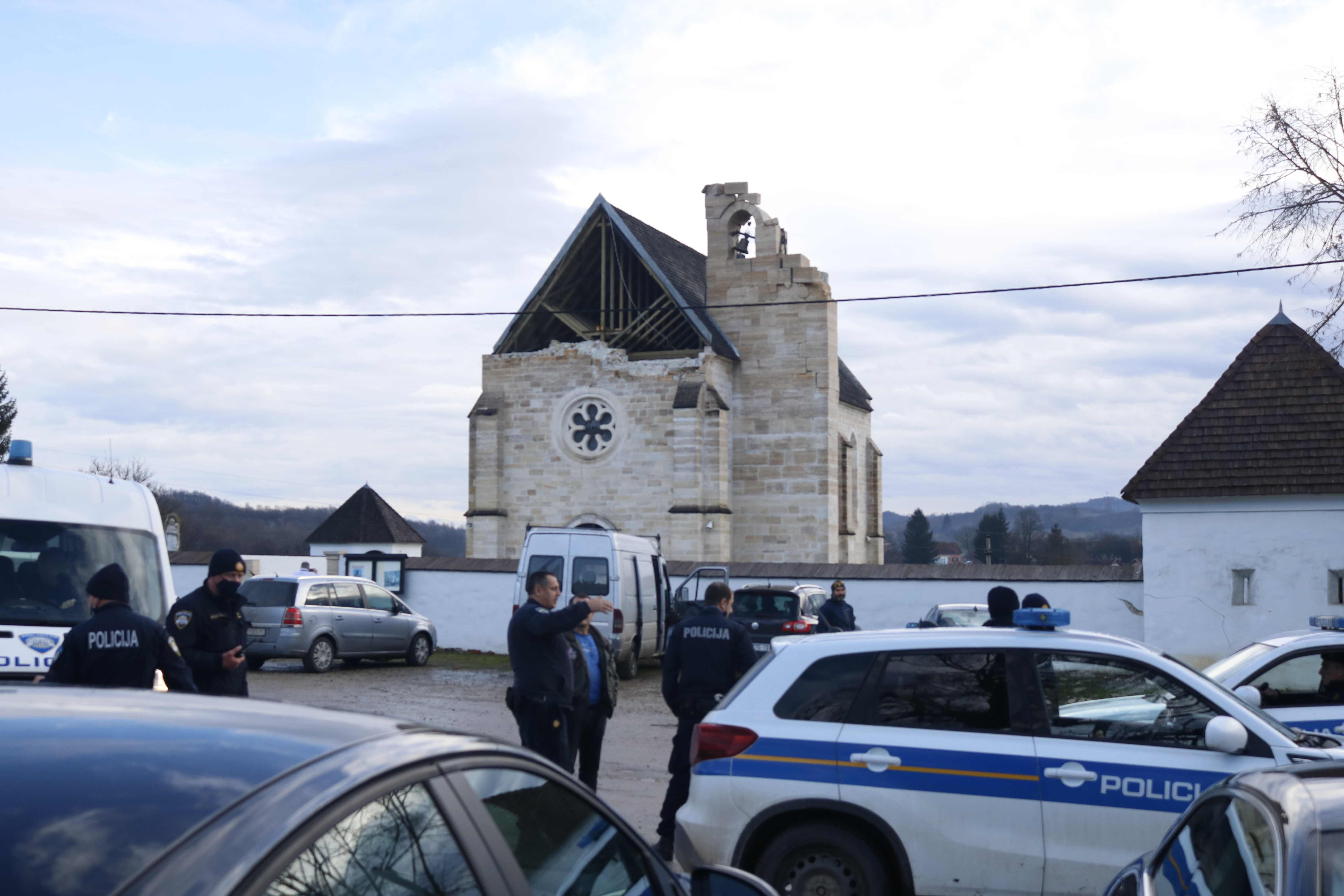
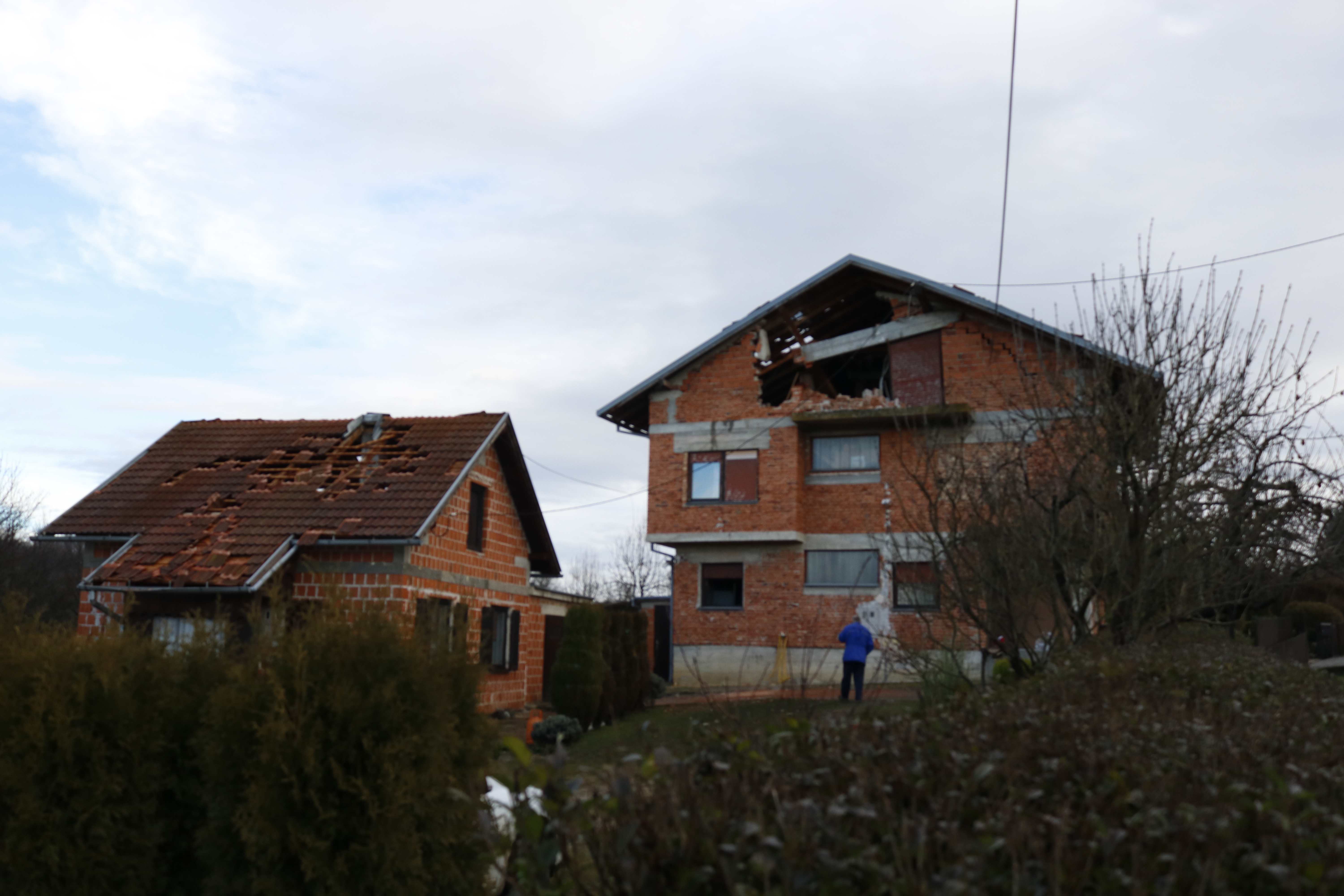

Even in the miserably wet winter weather, the greeting sign to Petrinja one day after the earthquake might still have looked cheery, if you couldn't see all the emergency vehicles in the background. 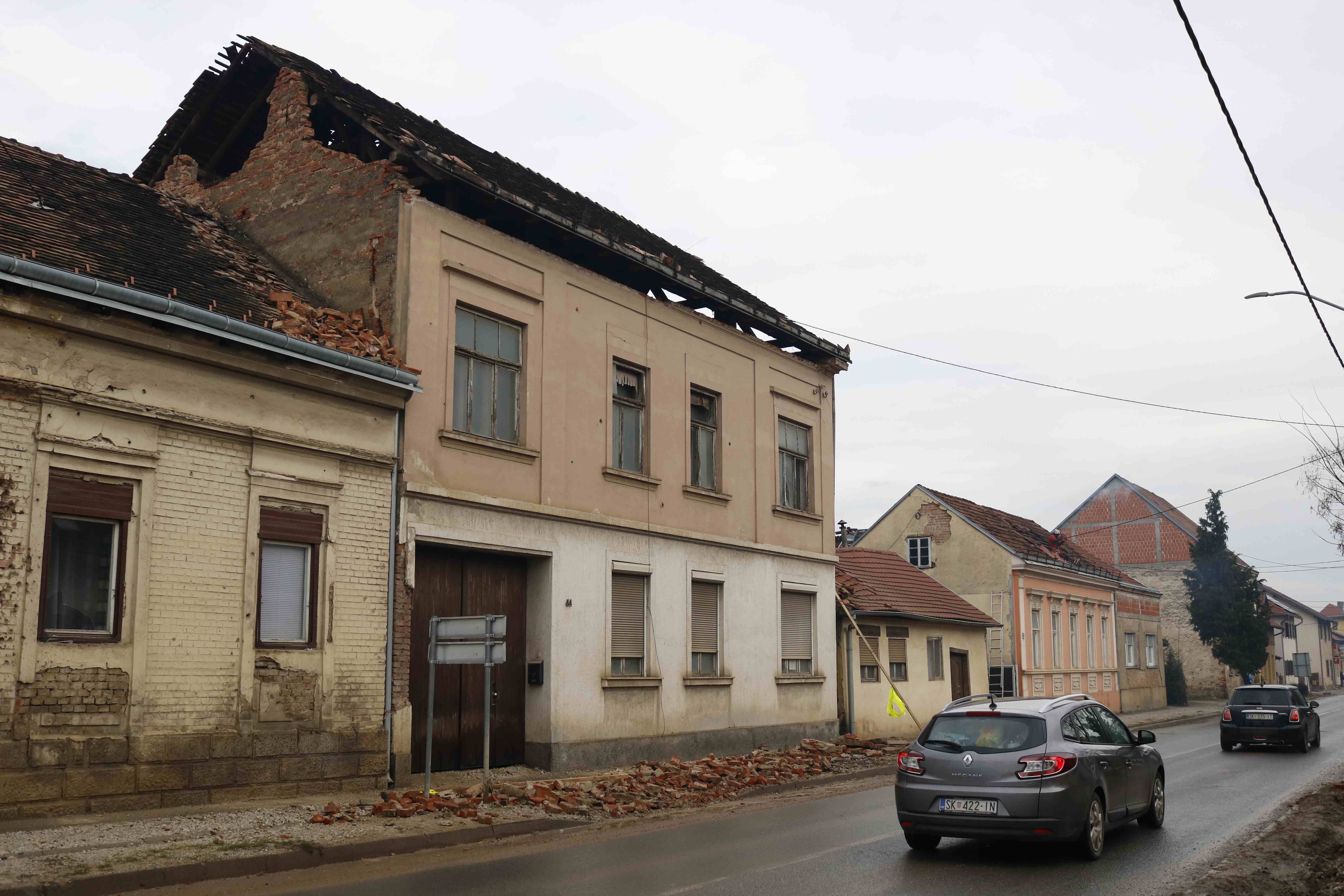
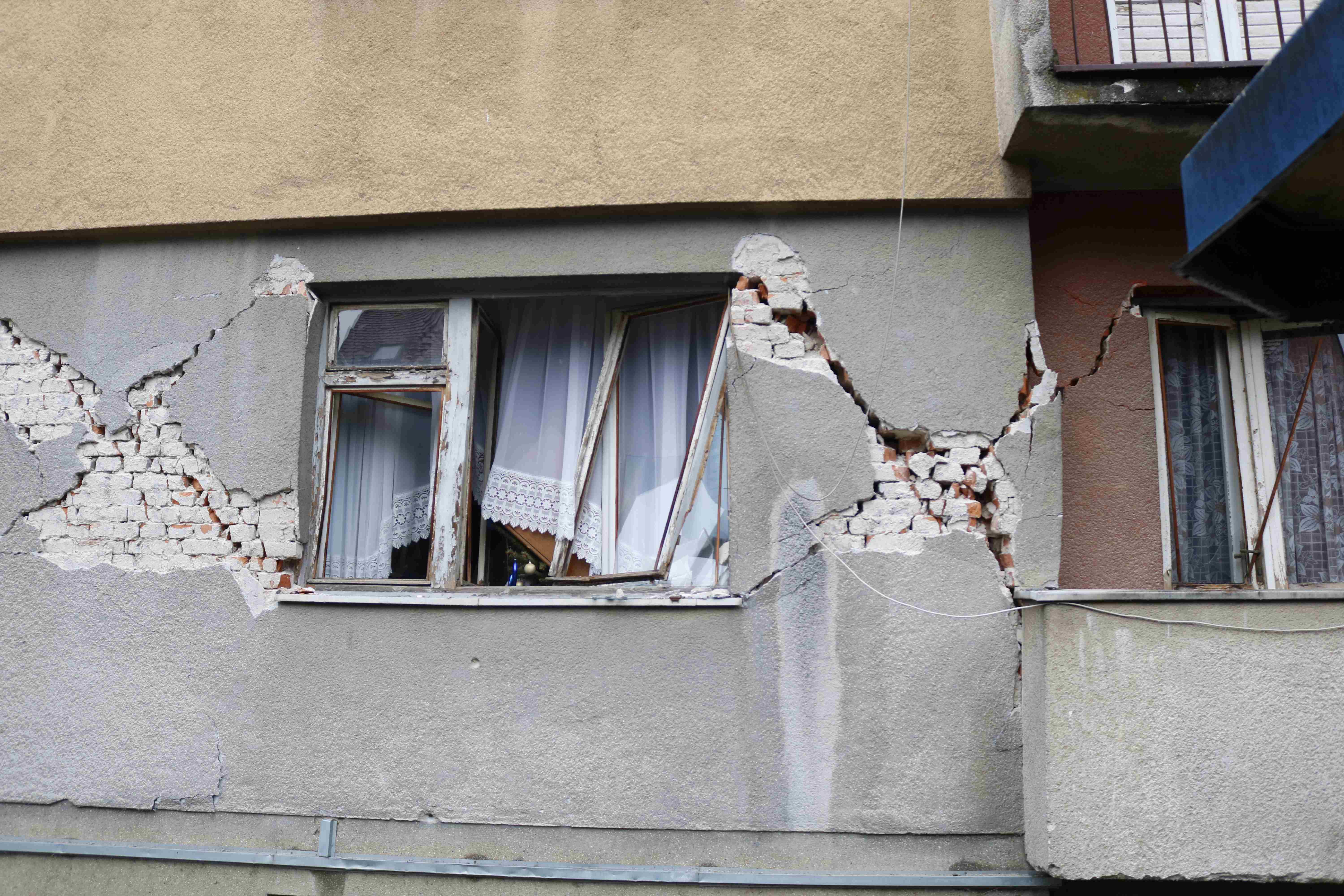
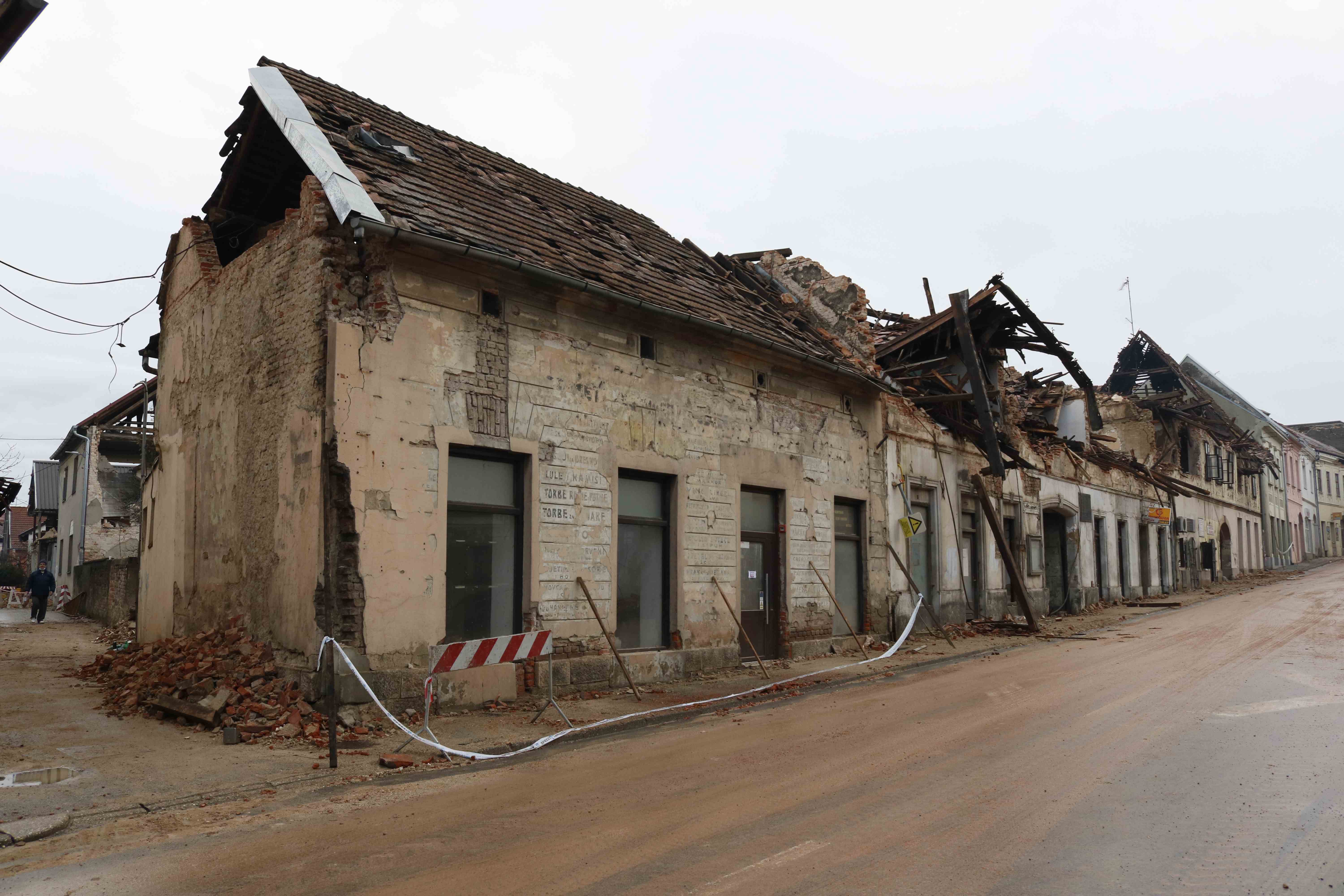
If you didn't know any better, these might look like damaged derelict buildings. But, 24 hours earlier, these had been a row of thriving storefronts, right in the centre of Petrinja one day after the earthquake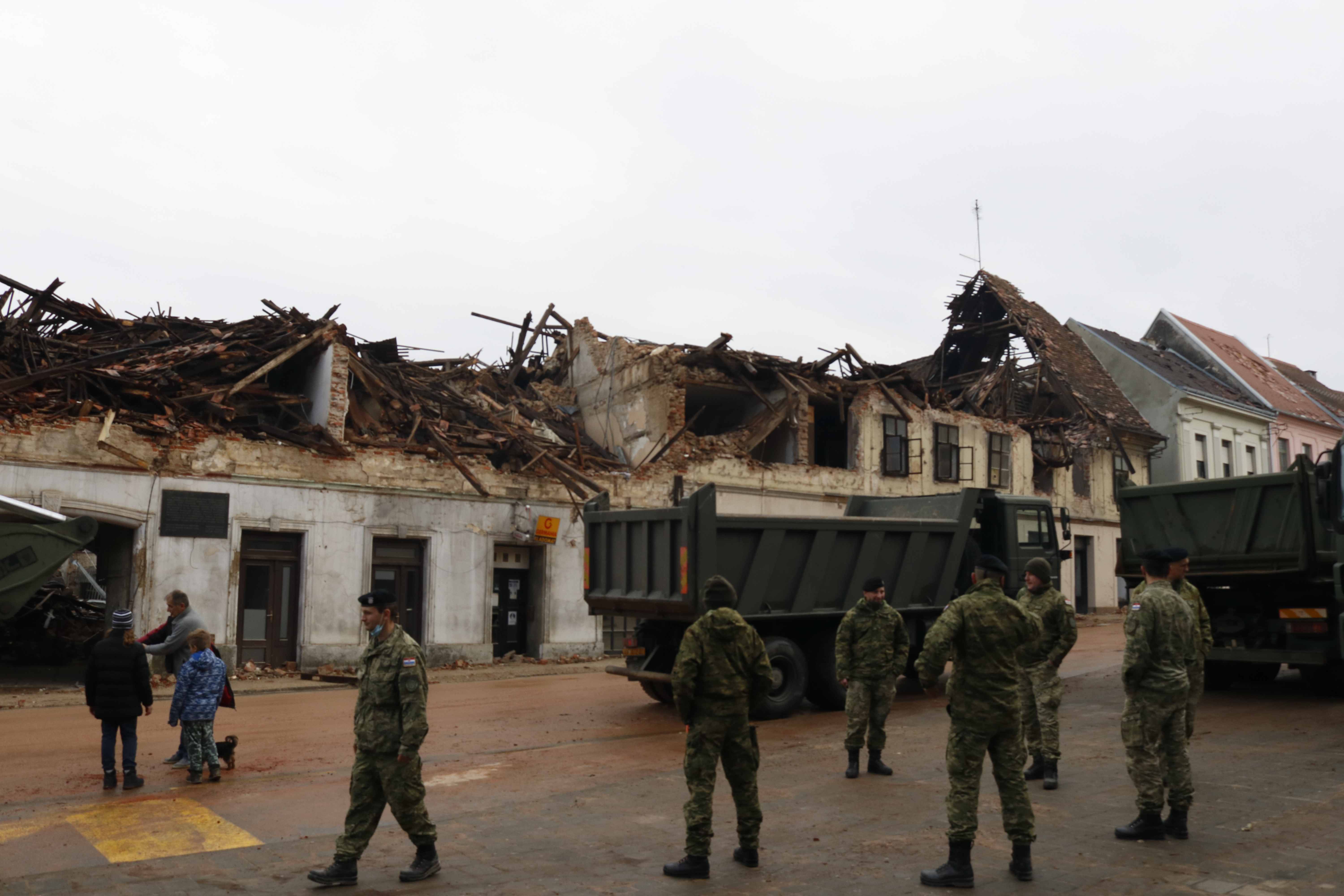
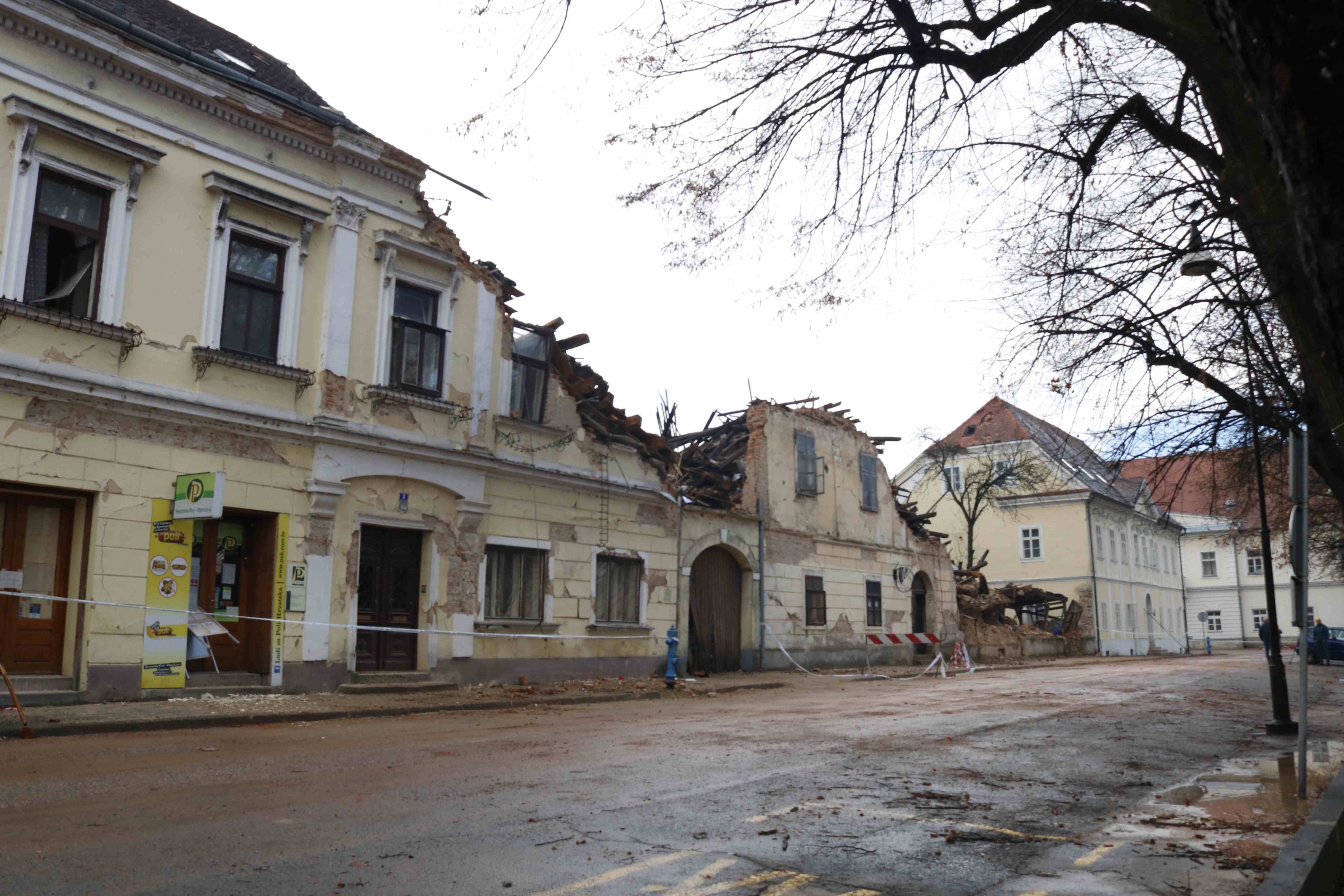

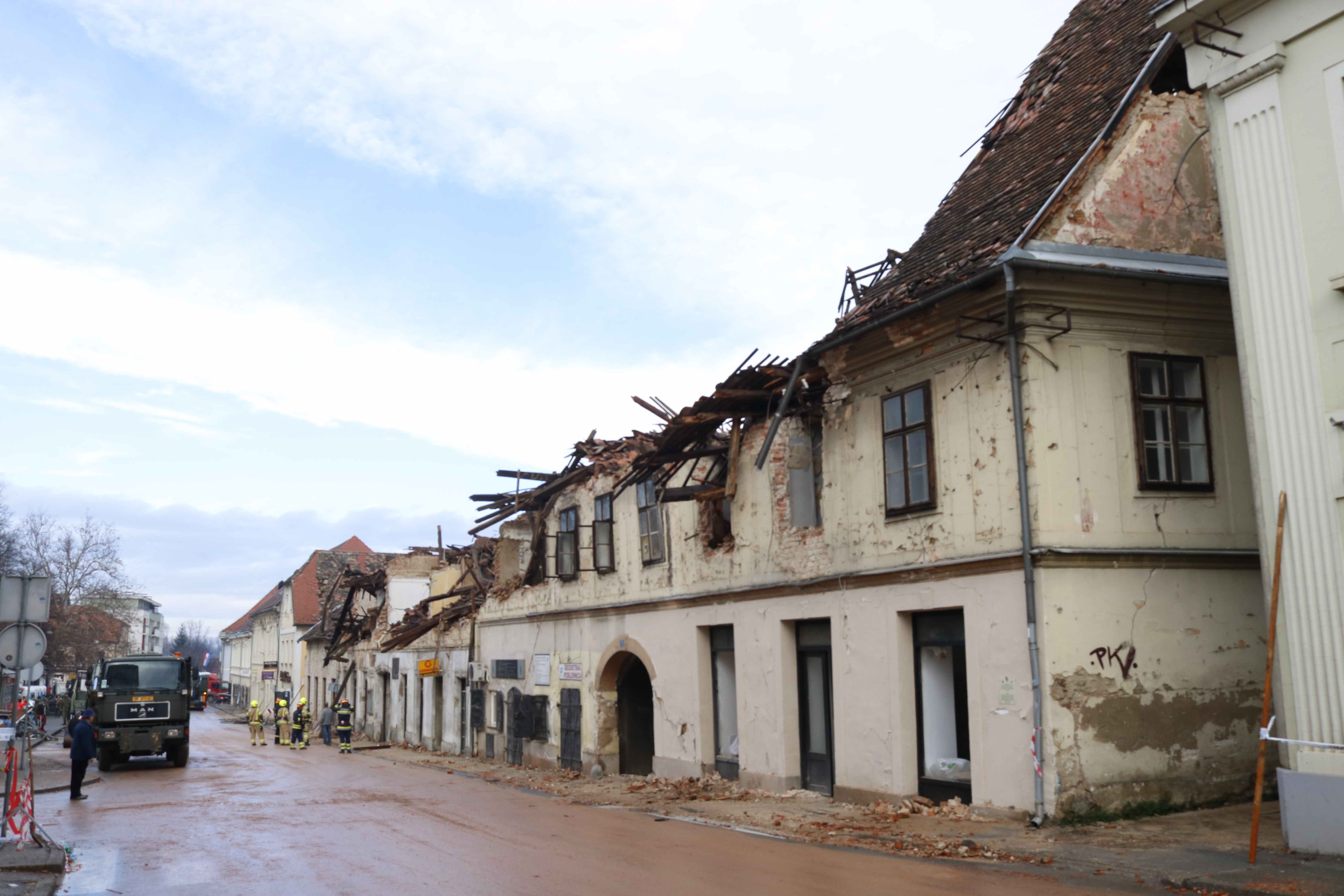
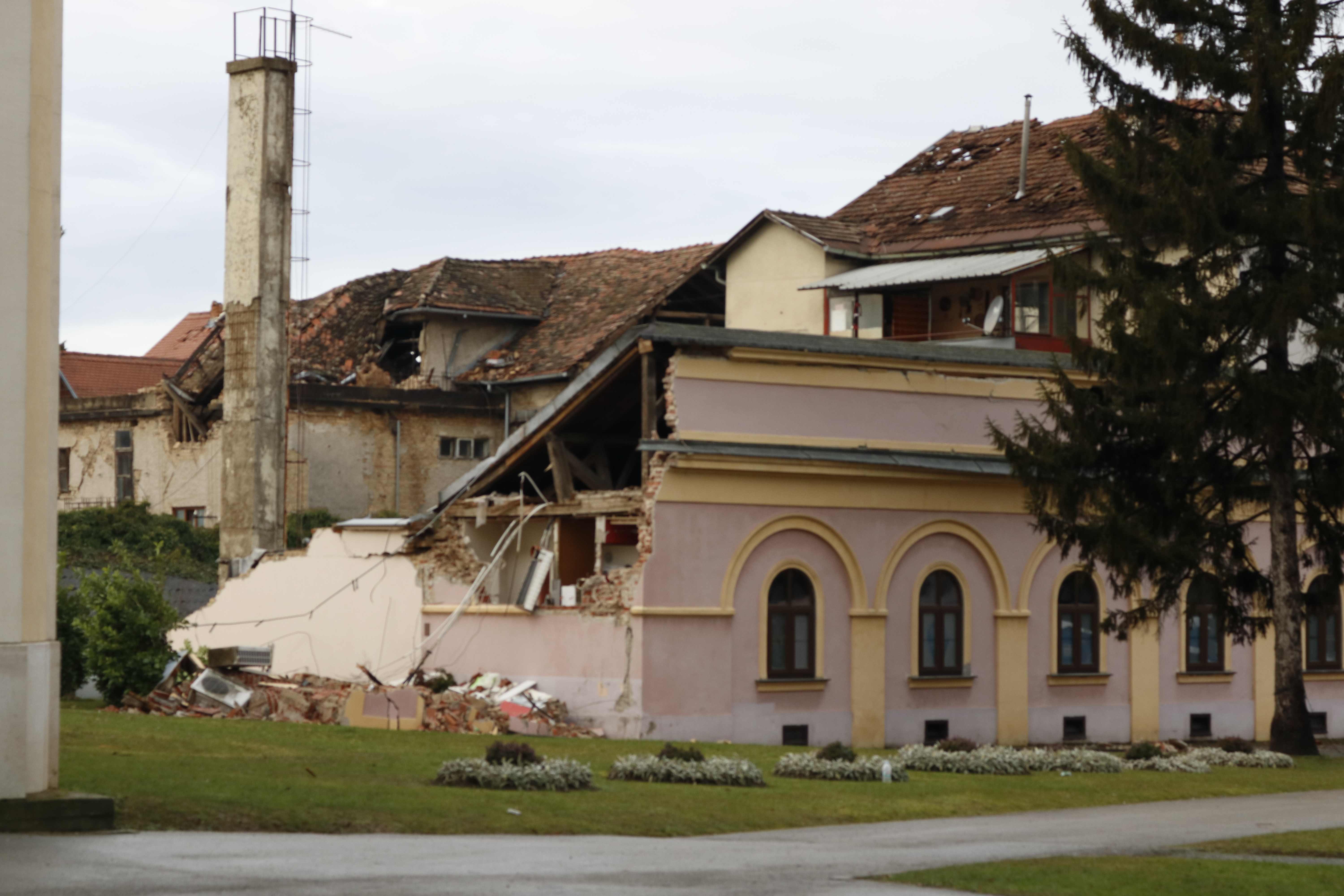
Sisak

Damage to the train station in Sisak. A considerably larger city than Petrinja one day after the earthquake, not one business we passed was working - no supermarkets, no fast-food restaurants. Nothing. Groups of teenagers roamed the streets with nothing to do and nowhere to go
Zazina

The Parish church of St. Nikola and Vida, Žažina near Petrinja one day after the earthquake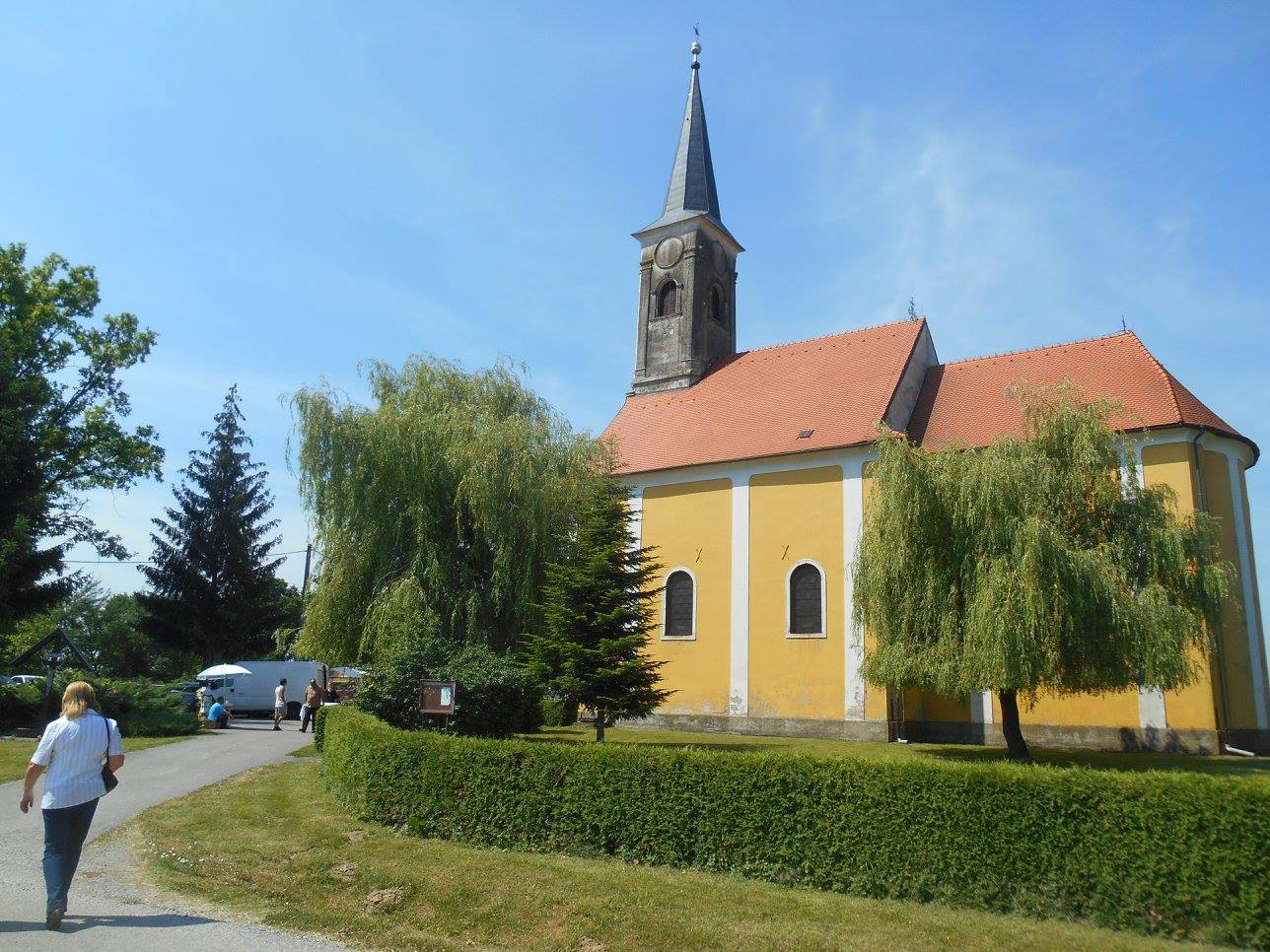
This is how the church had looked just one day earlier. A couple of metres from the church, remnants of the fire that parishioners had gathered around on Badnjak (Christmas Eve). We later learned that the church organist had been cleaning the organ when the earthquake struck, and tragically he was killed. 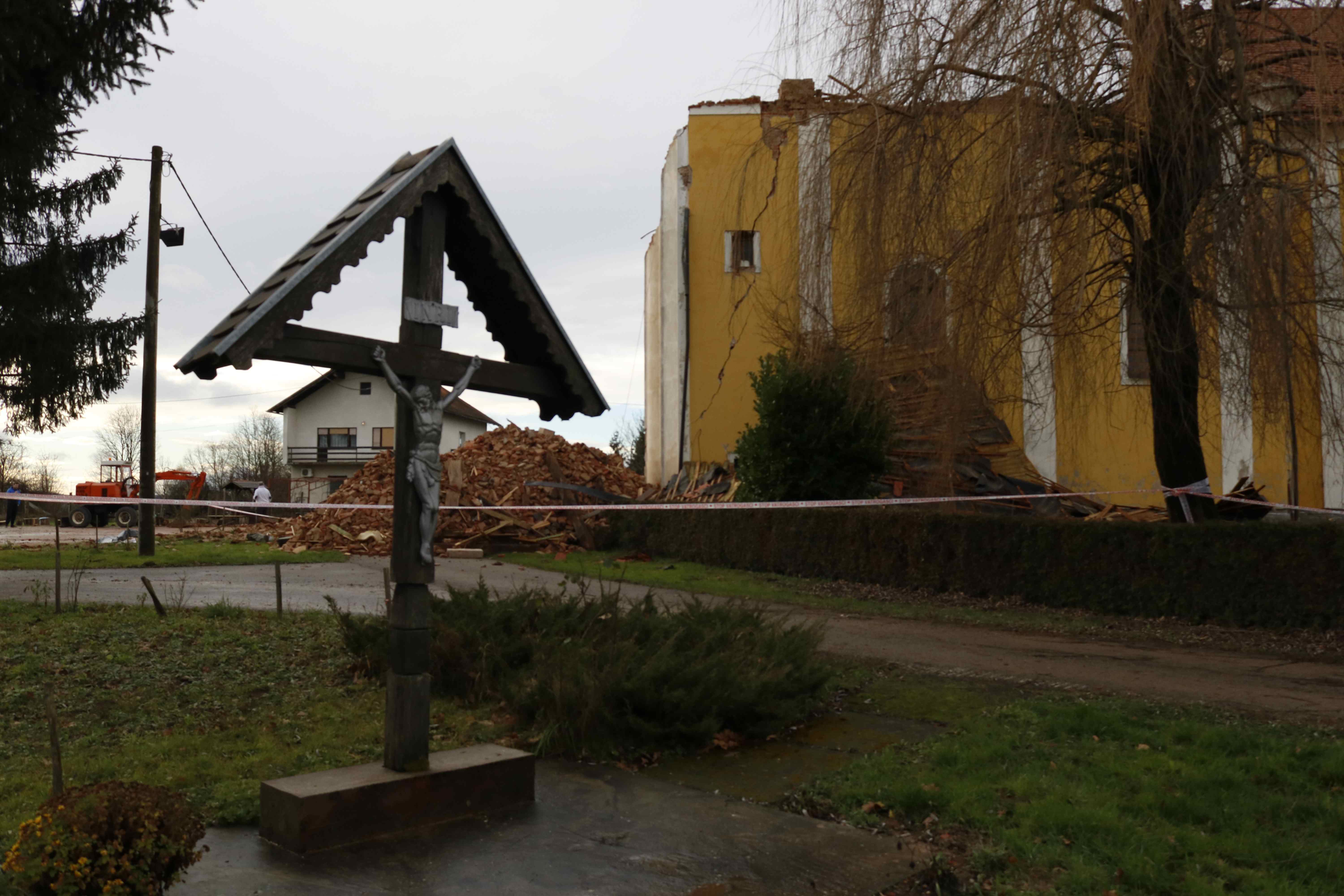
Photo of the Parish church of St. Nikola and Vida, Žažina courtesy of the church, all other photos © Marc Rowlands
Istria Sends a Convoy of Caravans to Petrinja: 'This Is Just the Beginning'
December 30, 2020 – For the part of the population who have lost a place to sleep, Istria sent a convoy of caravans to Petrinja and other earthquake-ravaged surrounding places.
After the Istrian firefighters went to help the injured in Petrinja and its surroundings yesterday, today Istrians showed a big heart again. Namely, in front of the Žatika hall in Poreč, a convoy of caravans headed towards the earthquake-affected areas.
As Jutarnji.hr reports, the caravan owners from Istria sent 16 of them, equipped, to Petrinja and Glina on Wednesday, so that part of the Petrinja and Glina residents could have a place to sleep.
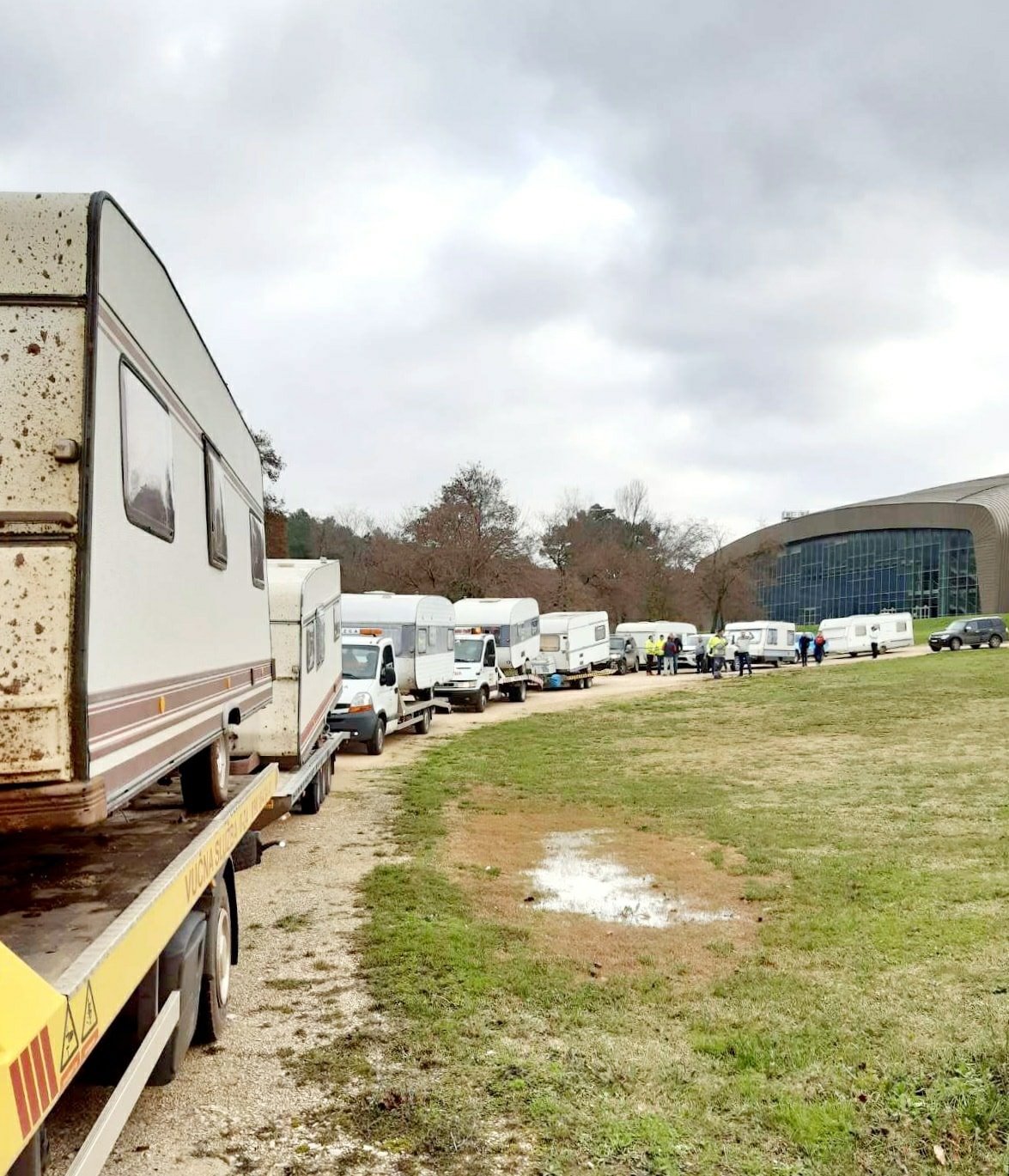
A convoy of caravans headed from Istria to Petrinja / Photo: the City of Poreč - Parenzo
This humanitarian action was initiated by Denis Bernobić from Poreč, the owner of a local towing service, together with the owner of a small family camp Polidor near Funtana, Adrian Ukušić. According to both of them, whom Jutarnji found in a convoy near Rijeka while transporting the first contingent of houses, this is just the beginning.
"Private owners of caravans responded to the action, and among them are even some Germans who have their caravan in the Bijela Uvala camp near Poreč. They called me and said they were giving their caravan away with all the papers. People immediately started appearing like crazy from all over Istria, so this is only the first contingent," says Bernobić, who set off for Petrinja and Glina on Wednesday together with colleagues with eight trucks, seven jeeps, and two vans.
They are driving caravans directly to people who were left without roofs and slept outside last night, and they have everything – toilets, beds, and heating.
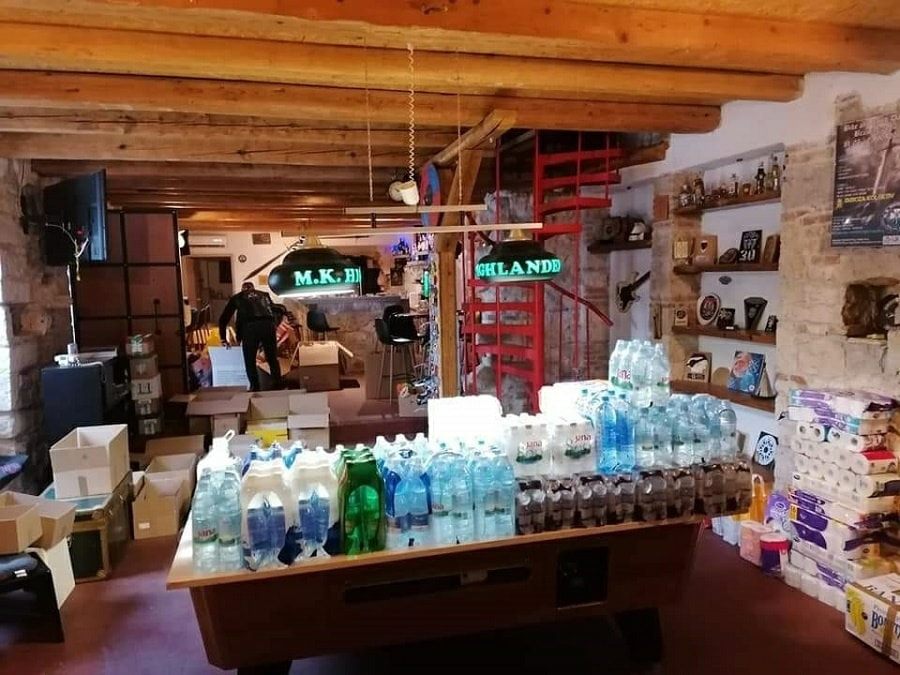
The caravans are equipped with food and drinks / Photo: the City of Poreč - Parenzo
"The caravans are also full of drinks and food. There are even wood and wood stoves inside. The van is full of bedding. Everyone helped us to equip them, and the Red Cross from Poreč and Rovinj were especially active, and I thank them for that," says Bernobić, whose phone keeps ringing.
"They keep calling me across all platforms because people want to give away their caravans. So we will drive towards Petrinja and Glina in the coming days as well. We expect to take about 40 caravans to the affected areas in the next few days. Colleagues from Koper and Slovenia who have a towing service also call me to help us take the campers, "points out Bernobić, who took similar action with Ukušić when Gunja was flooded.
The owner of Polidor was also with him in convoy, and he gave two of his camps. Mayor of Poreč Loris Peršurić also supported Bernobić.
"These are all donations from citizens from all over Poreč and beyond. Poreč Red Cross, local committees, and numerous associations and initiatives still collect all kinds of help. This is an unprecedented tragedy. The minimum we can do is help people whose homes have been destroyed, who are terrified, and whose horrors, unfortunately, are not over yet," Mayor Peršurić told Hina.
Follow our live updates on the situation in Croatia's earthquake-hit areas here; find out how you can donate here.
Croatians Rally, Offer Free Accommodation For Earthquake Affected
December 29, 2020 – As buildings toppled in Petrinja and Sisak today, Croatian emergency services were quick to respond. They weren't the only ones - the Croatian public has quickly rallied round to offer free accommodation for earthquake affected
The sound of sirens was heard for the second day running in in Sisak-Moslavina County today. Some emergency responders were still on the scene, in Petrinja and Sisak, dealing with the aftermath of yesterday's sizeable earthquake. Though today's was much larger, more sustained and much more devastating, Croatian firemen, police and ambulance services did not blink and occupied themselves with helping wherever it was needed. They weren't the only ones. Željko and Ružica Marinic of Villa Marinic (pictured) and Apartmani Marinic in Primosten were quick to offer free accommodation for earthquake affected at four free apartments. Their son-in-law David posted the offer - which also includes food and support for families with children - across social media
Željko and Ružica Marinic of Villa Marinic (pictured) and Apartmani Marinic in Primosten were quick to offer free accommodation for earthquake affected at four free apartments. Their son-in-law David posted the offer - which also includes food and support for families with children - across social media
Less than an hour after today's earthquake, help from private individuals flooded social media pages as Croatia rallied round to offer free accommodation for earthquake affected. Holiday homes across Dalmatia and Istria were readily given up as free accommodation for earthquake affected, many of them making their way to a dedicated Facebook group set up specifically for the purpose.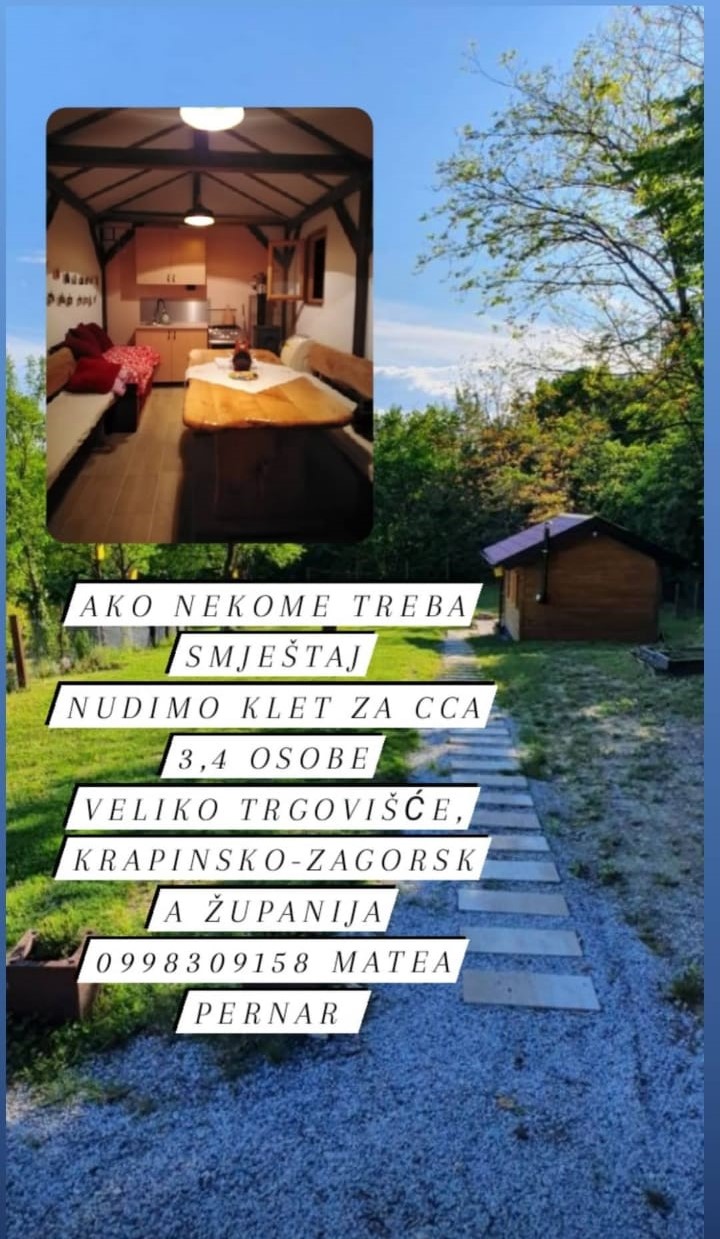
But, it wasn't just empty holiday villas by the coast that were made available. People across Croatia have offered to open up their own homes to offer free accommodation for earthquake affected. Apartments and sub-apartments in cities across the country have been made available. To offer free accommodation for earthquake affected for tonight and for however long necessary is a timely and generous move by these private citizens – at just after 4.30pm this evening, rain started to pour down on the affected area and those still stuck outside. Support and offers of accommodation came not only from Croatians at home in the country - Croatian National Team footballer Dejan Lovren opened up the doors to the hotel he owns in Novalja, Pag island for those affected by the earthquake in Petrinja.
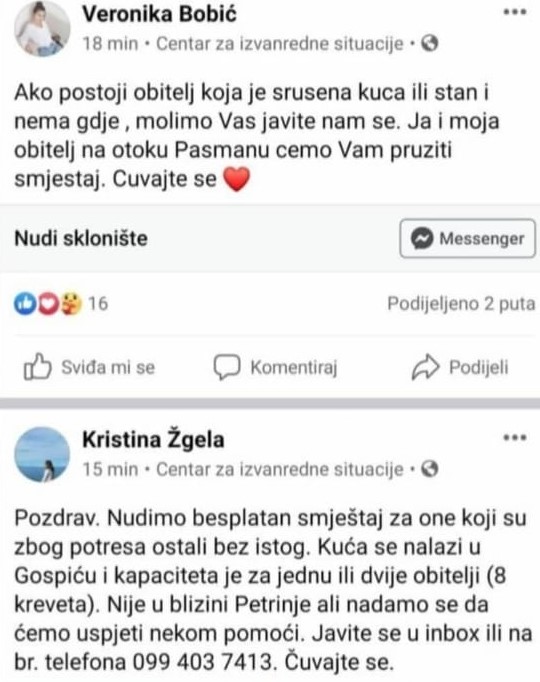
Recognising the gravity of the situation, Croatian authorities revoked travel restrictions between the country's counties in order to facilitate volunteers and family members travelling to Sisak-Moslavina County today to help out, and to allow residents of the county to take up the offer of free accommodation for earthquake affected.